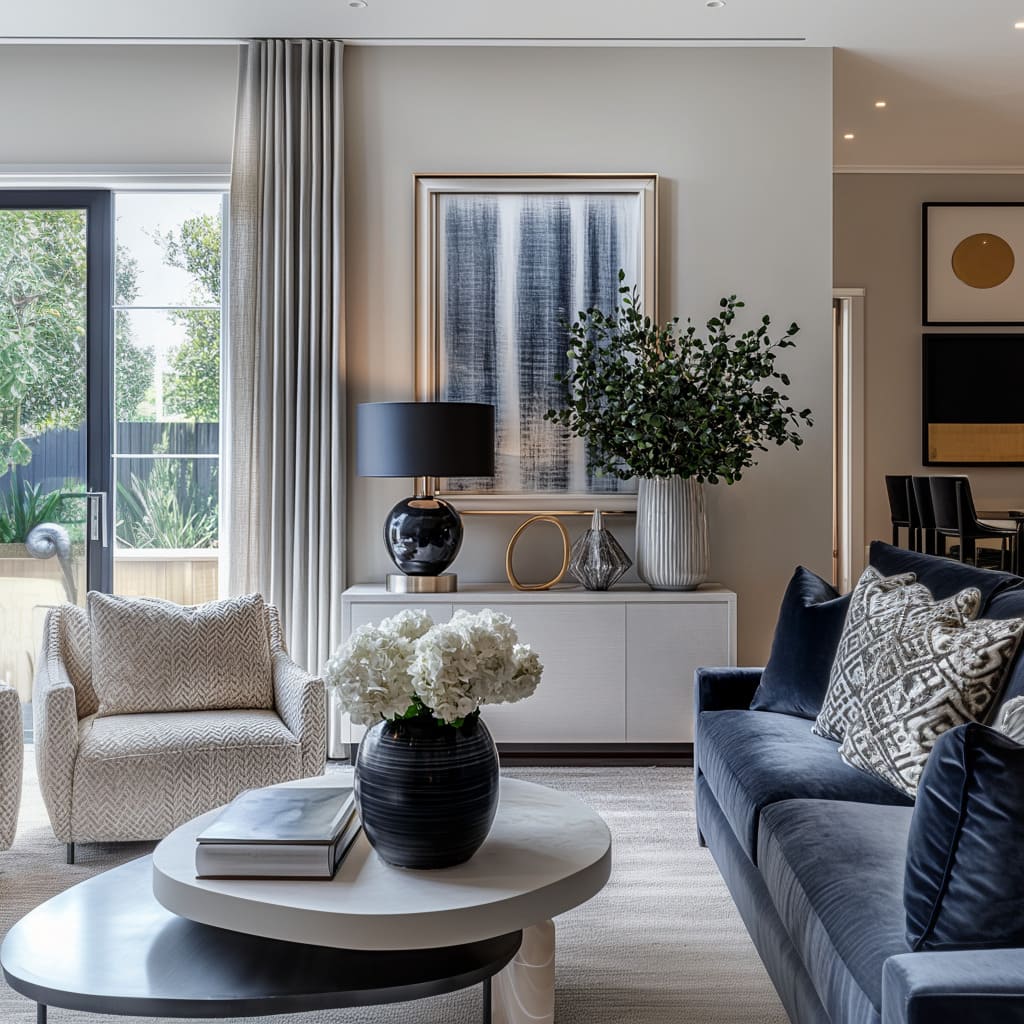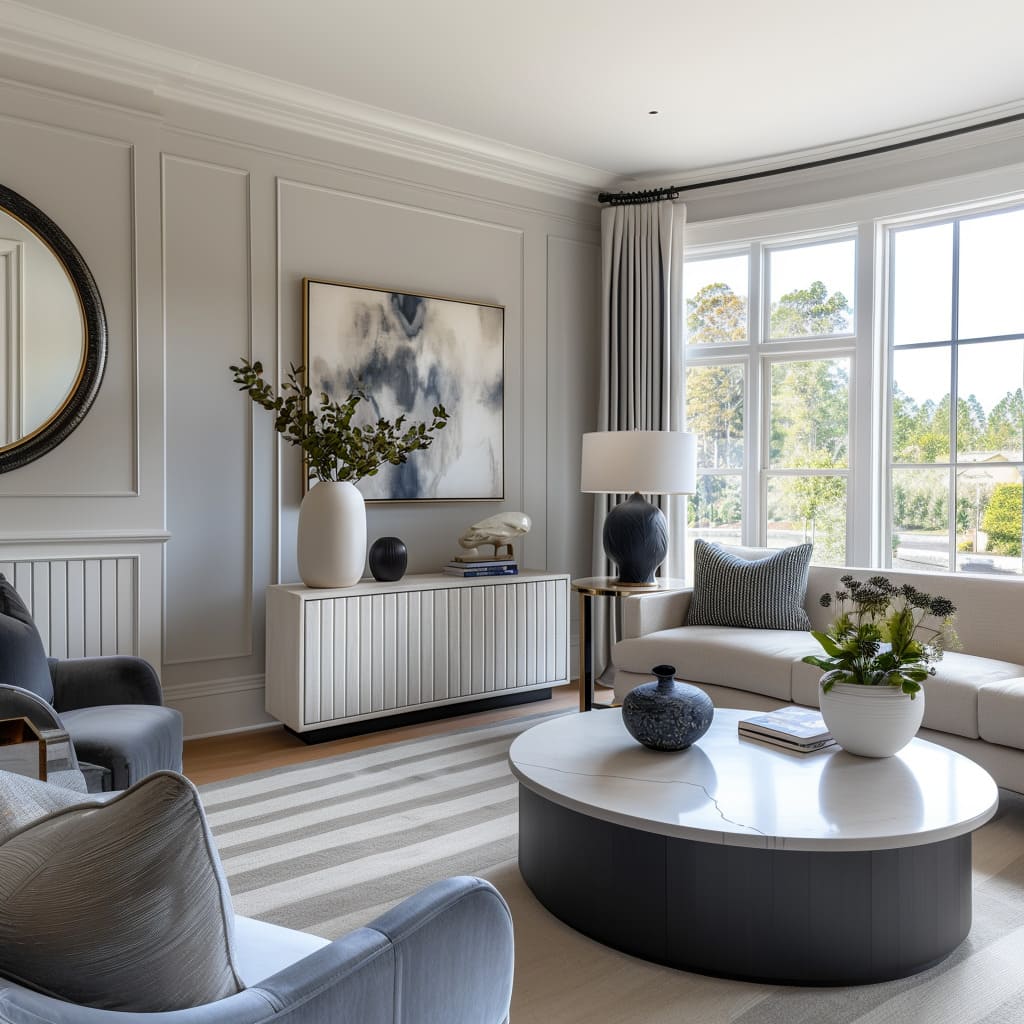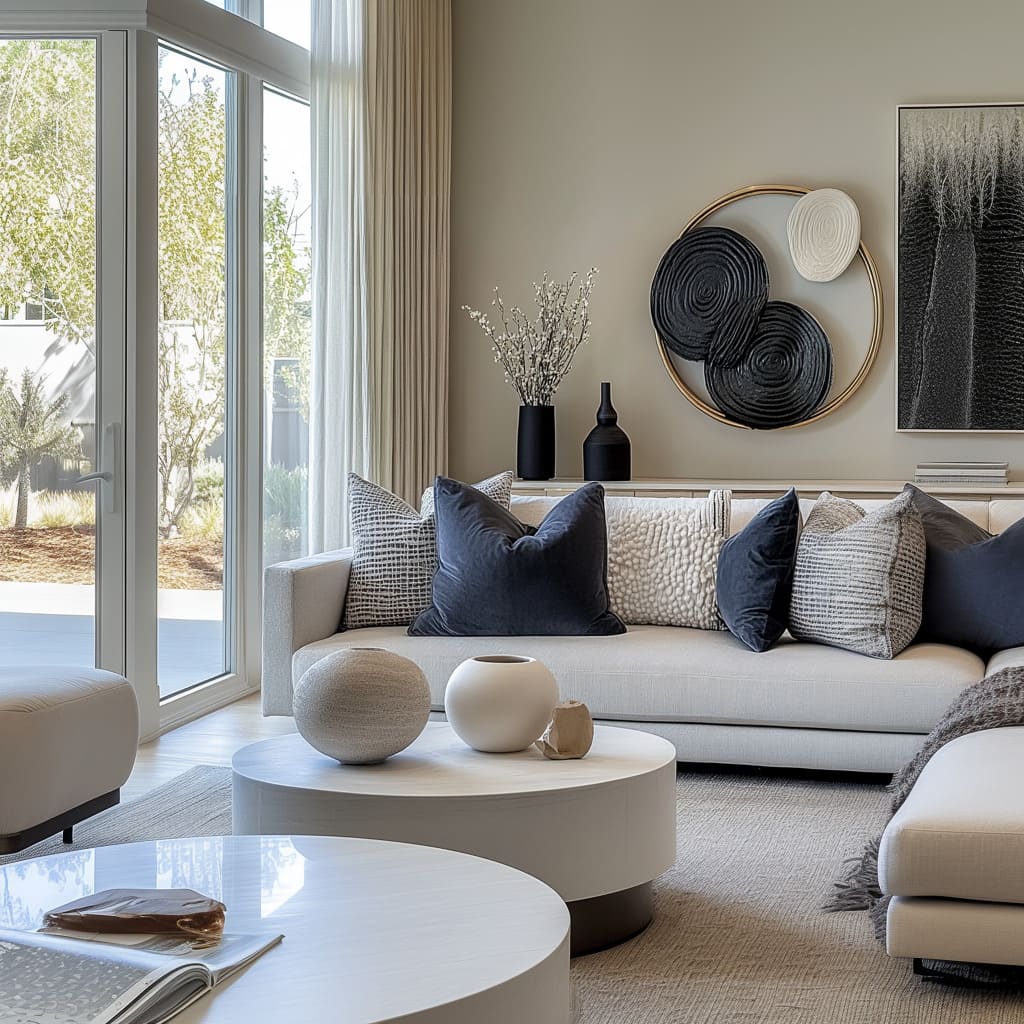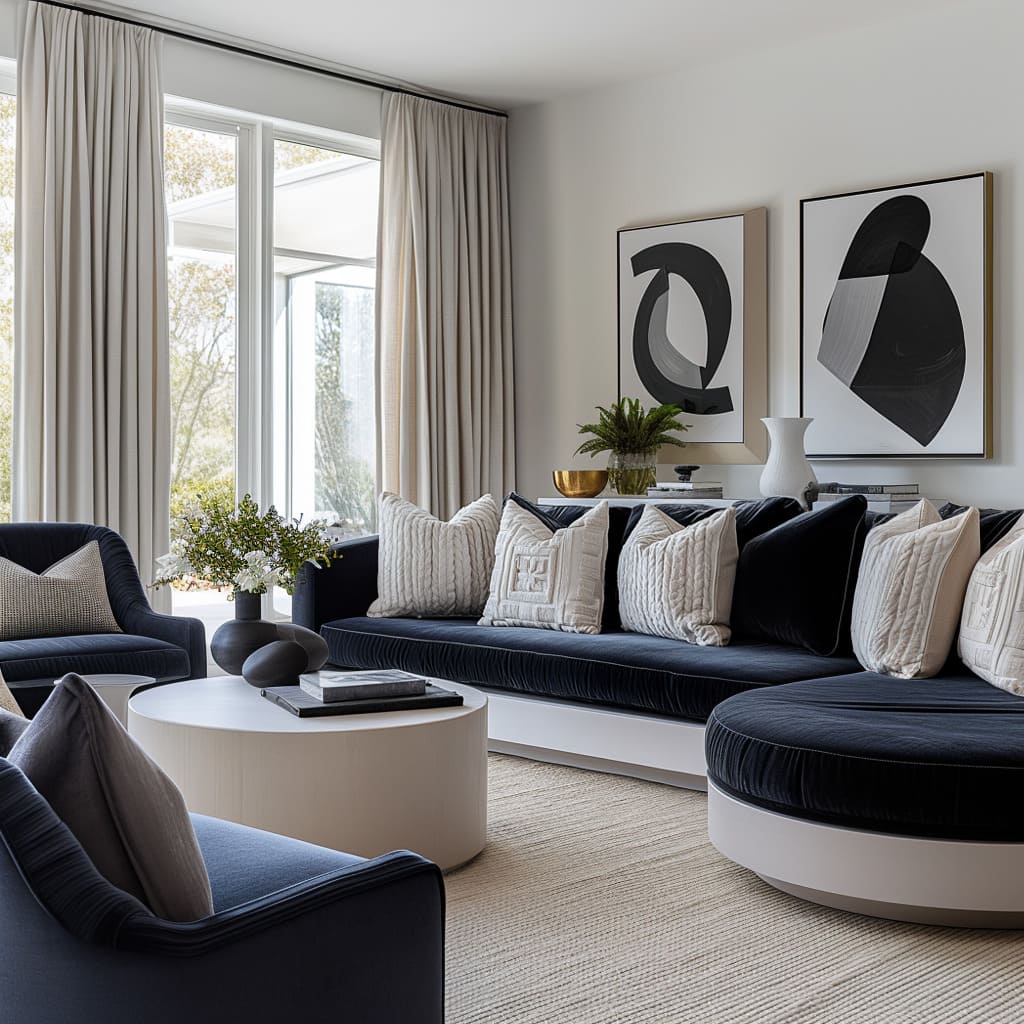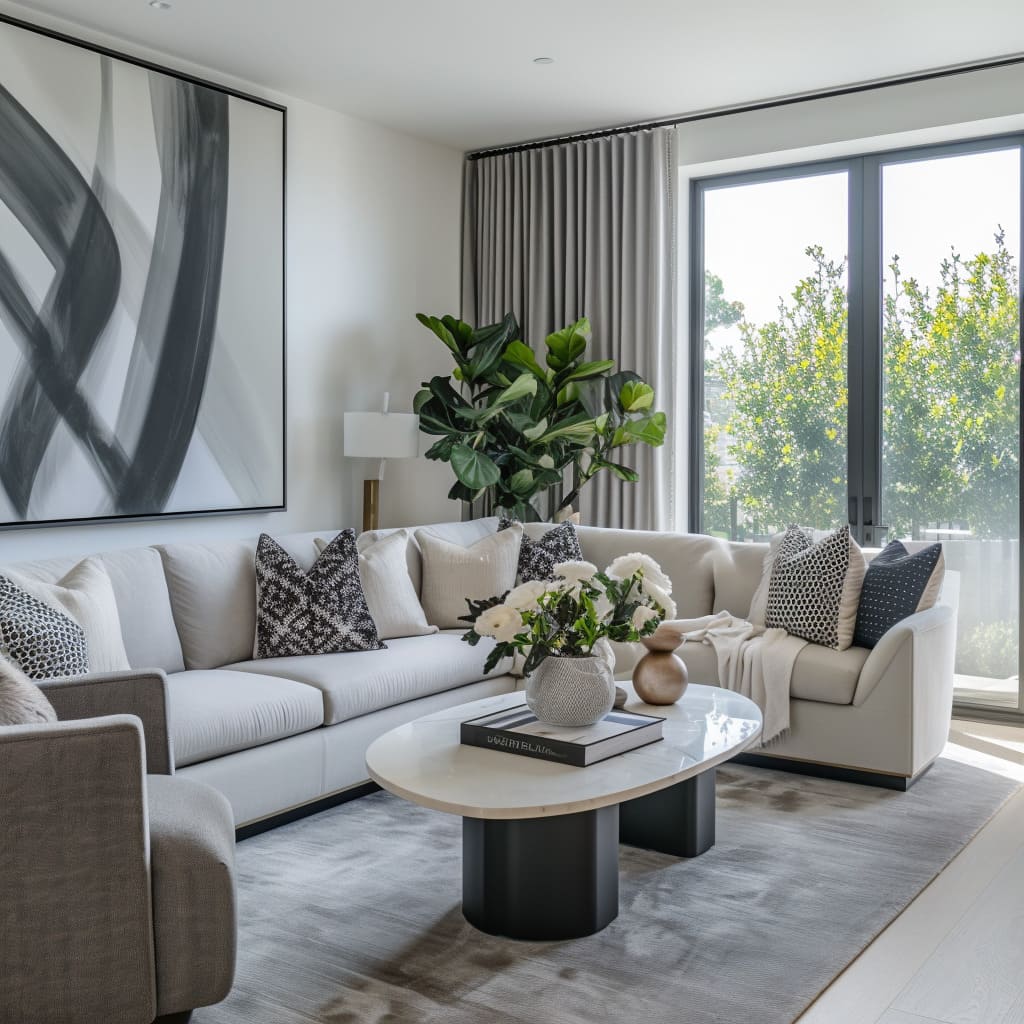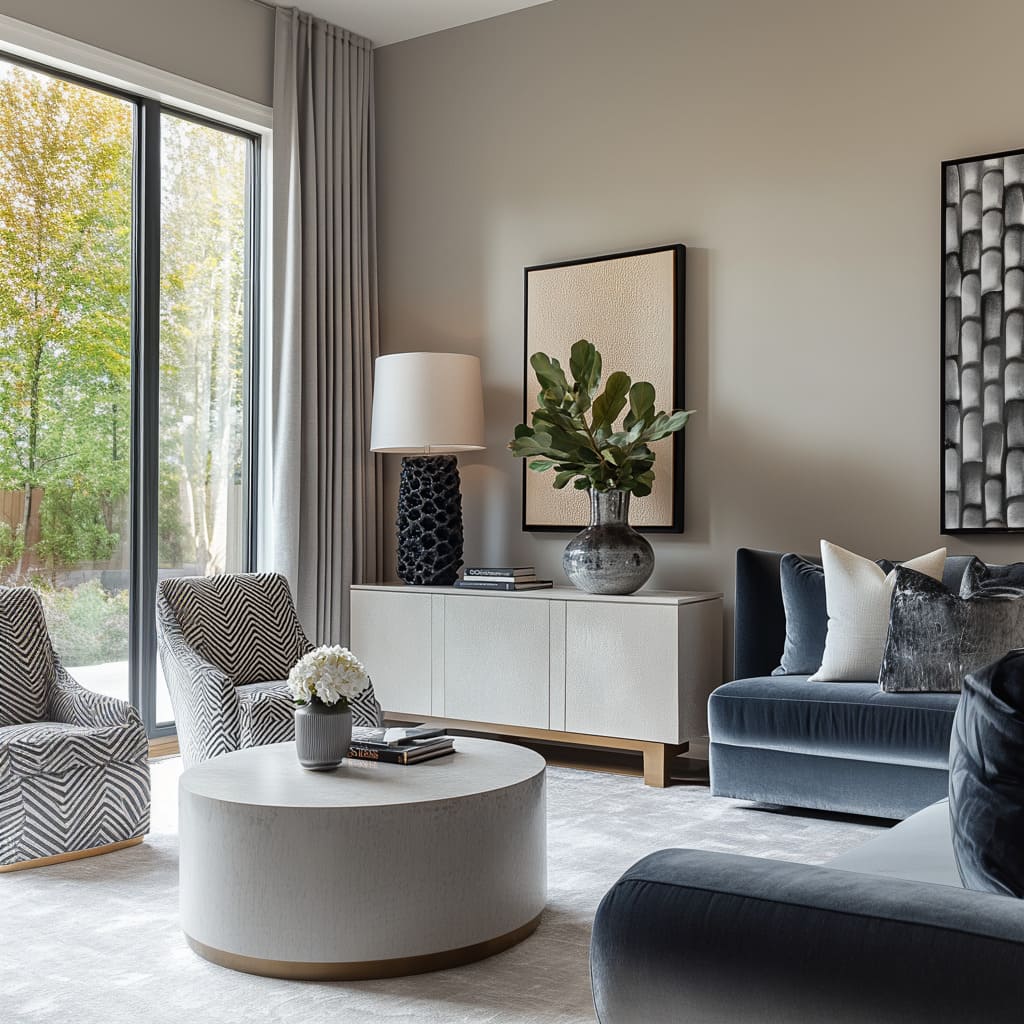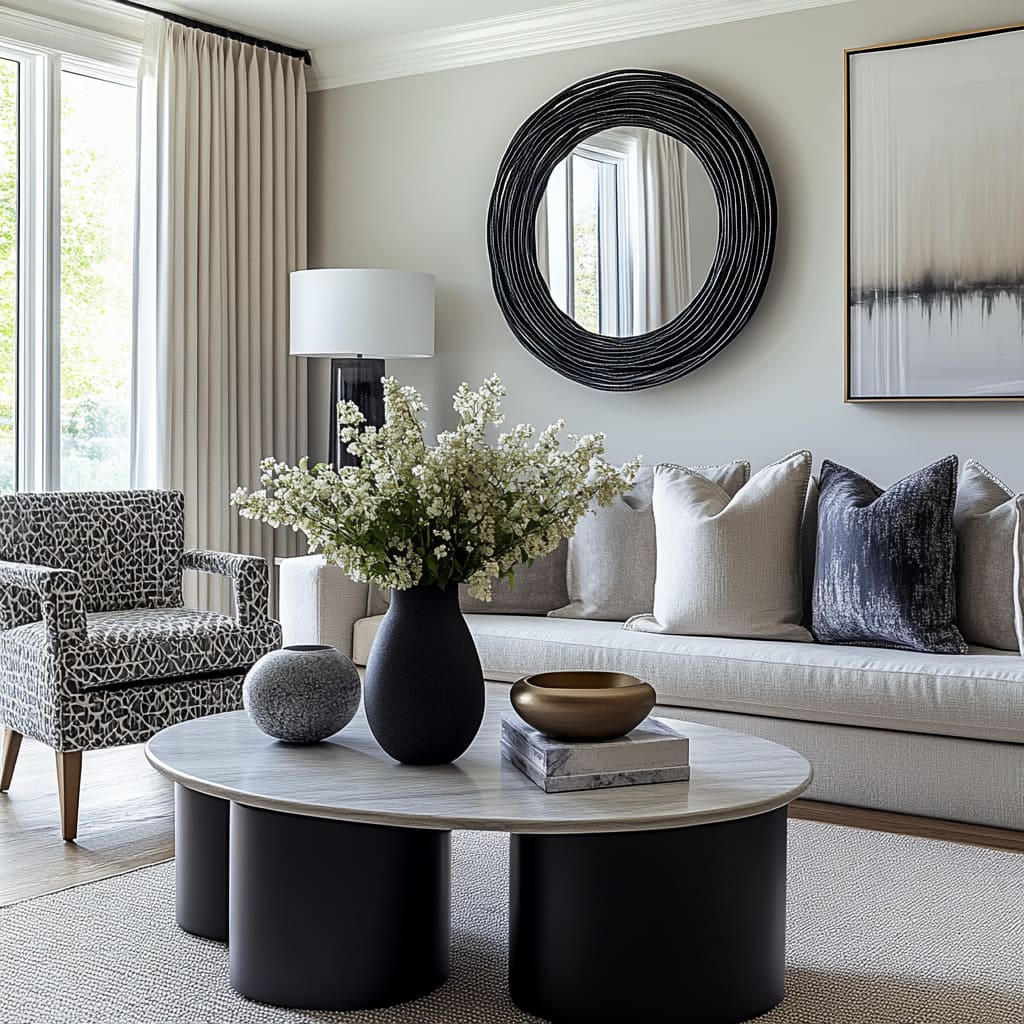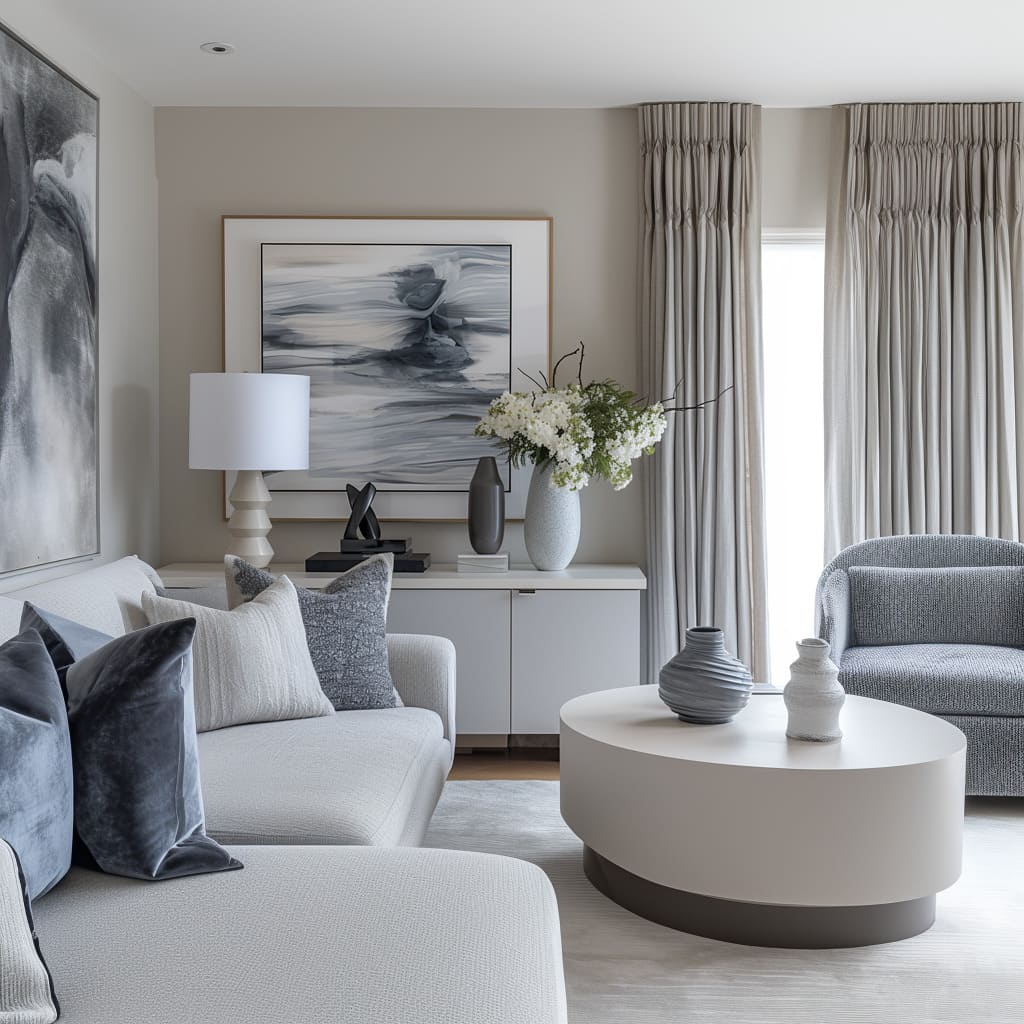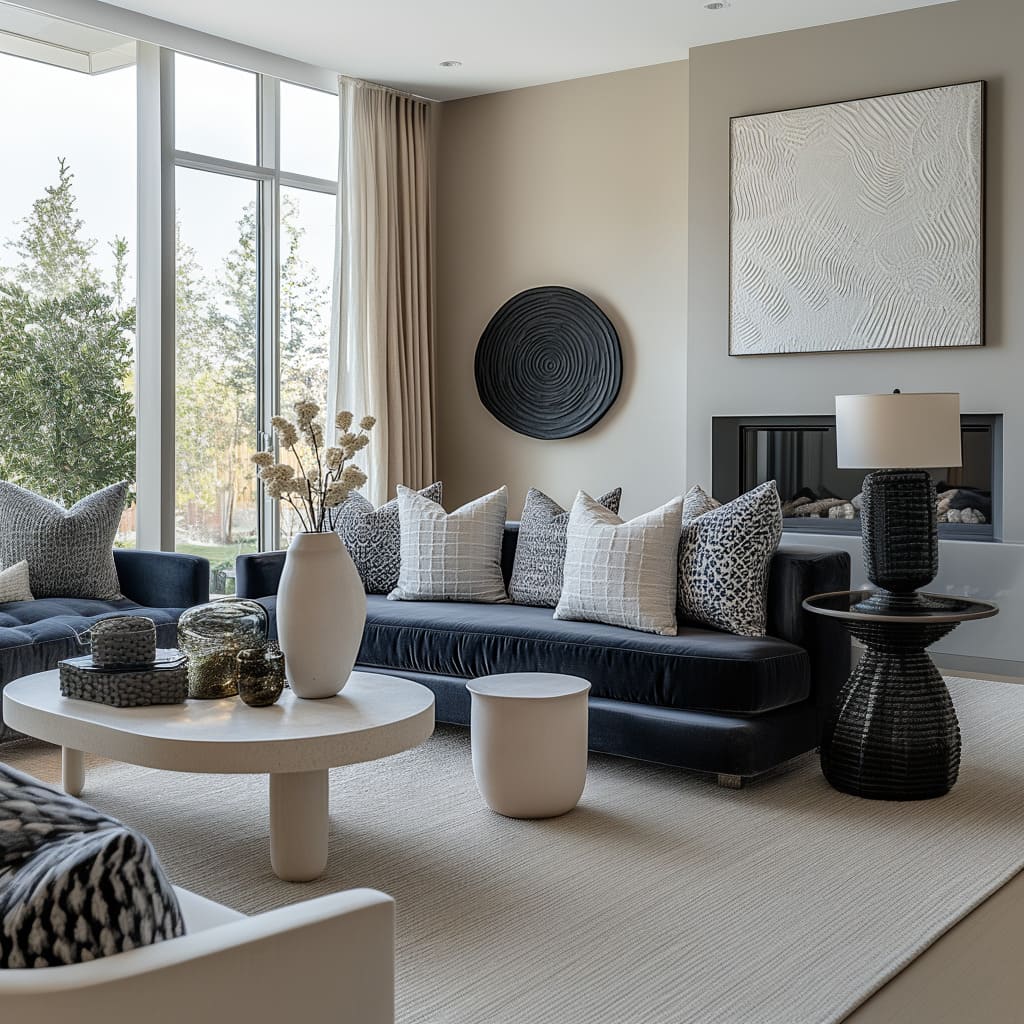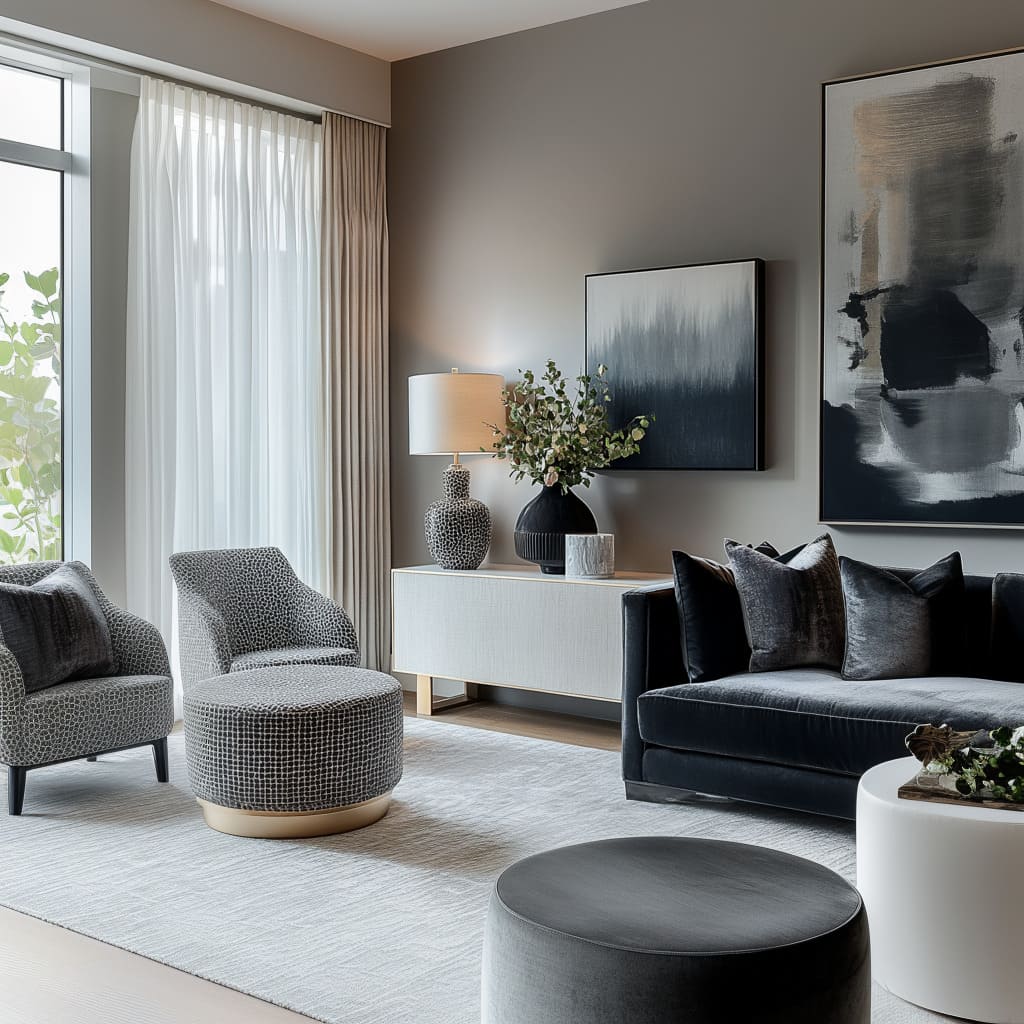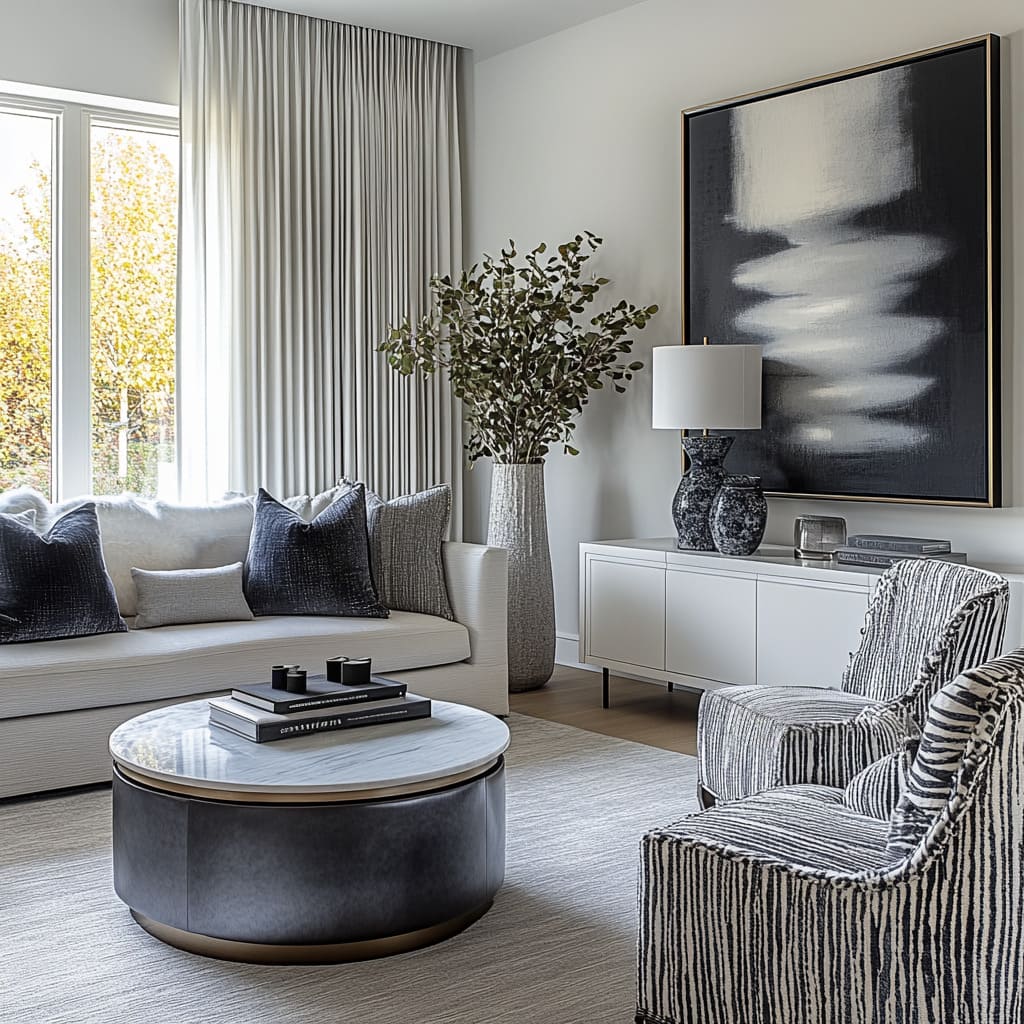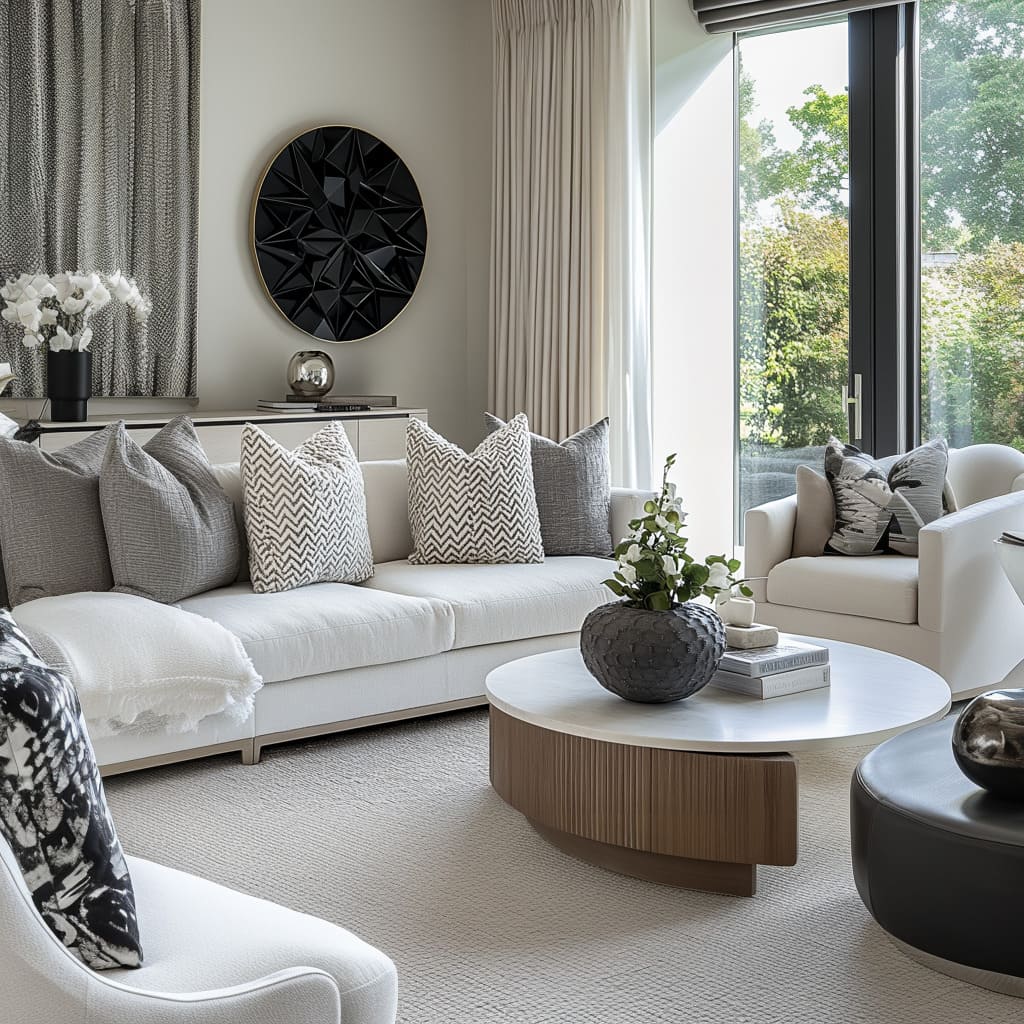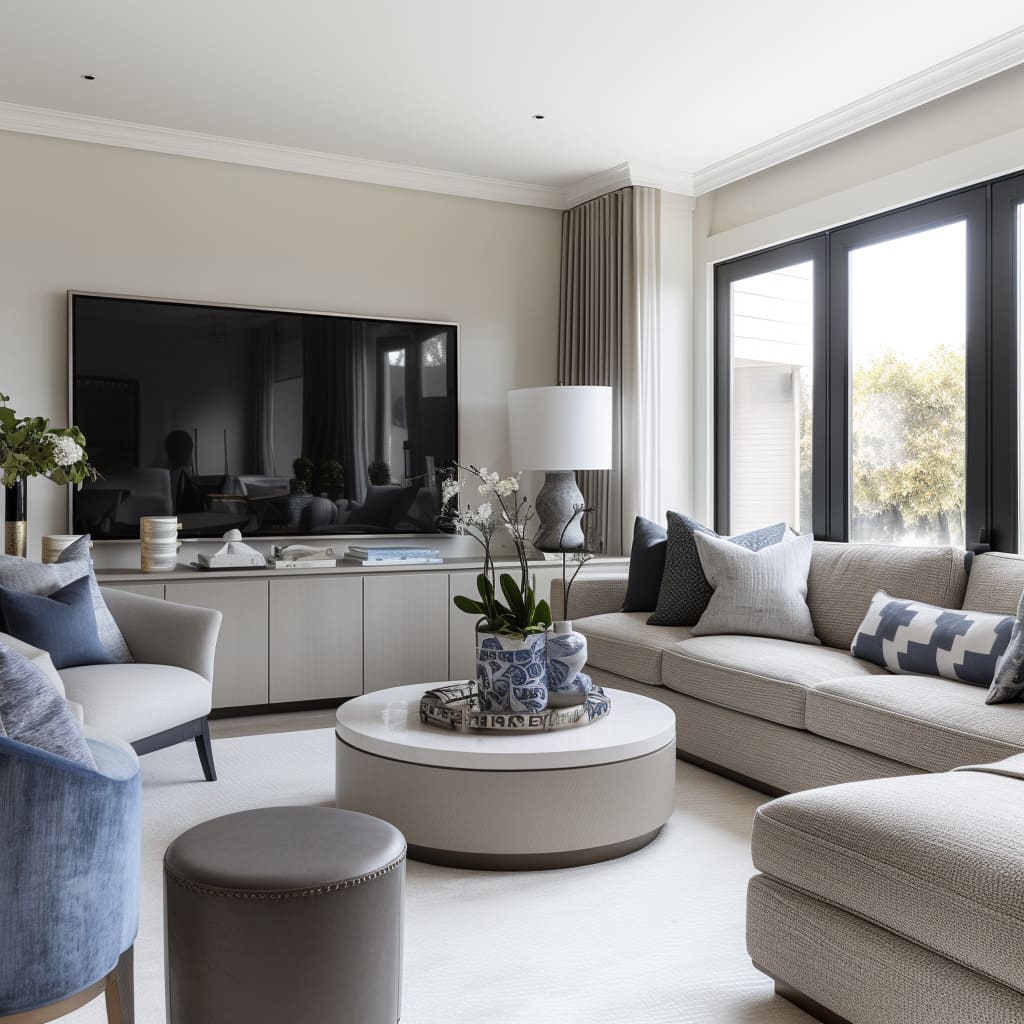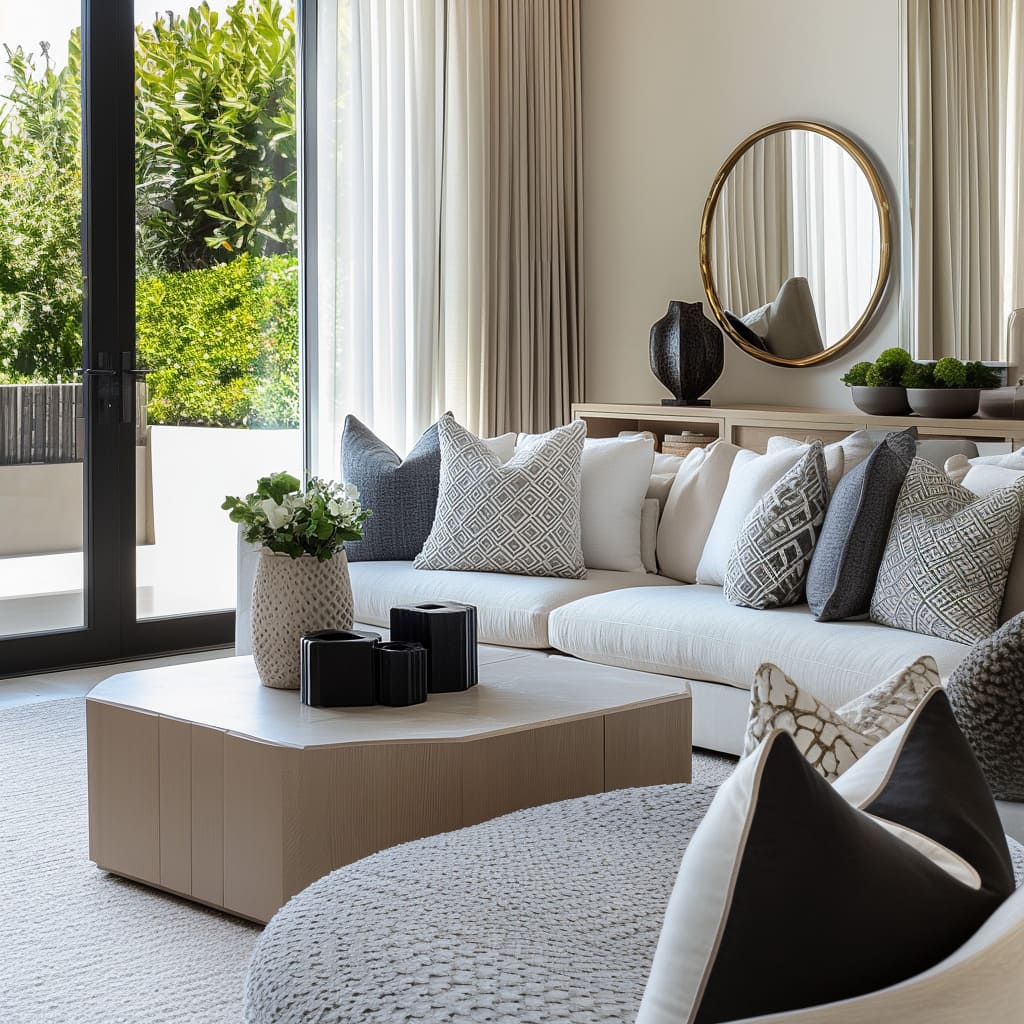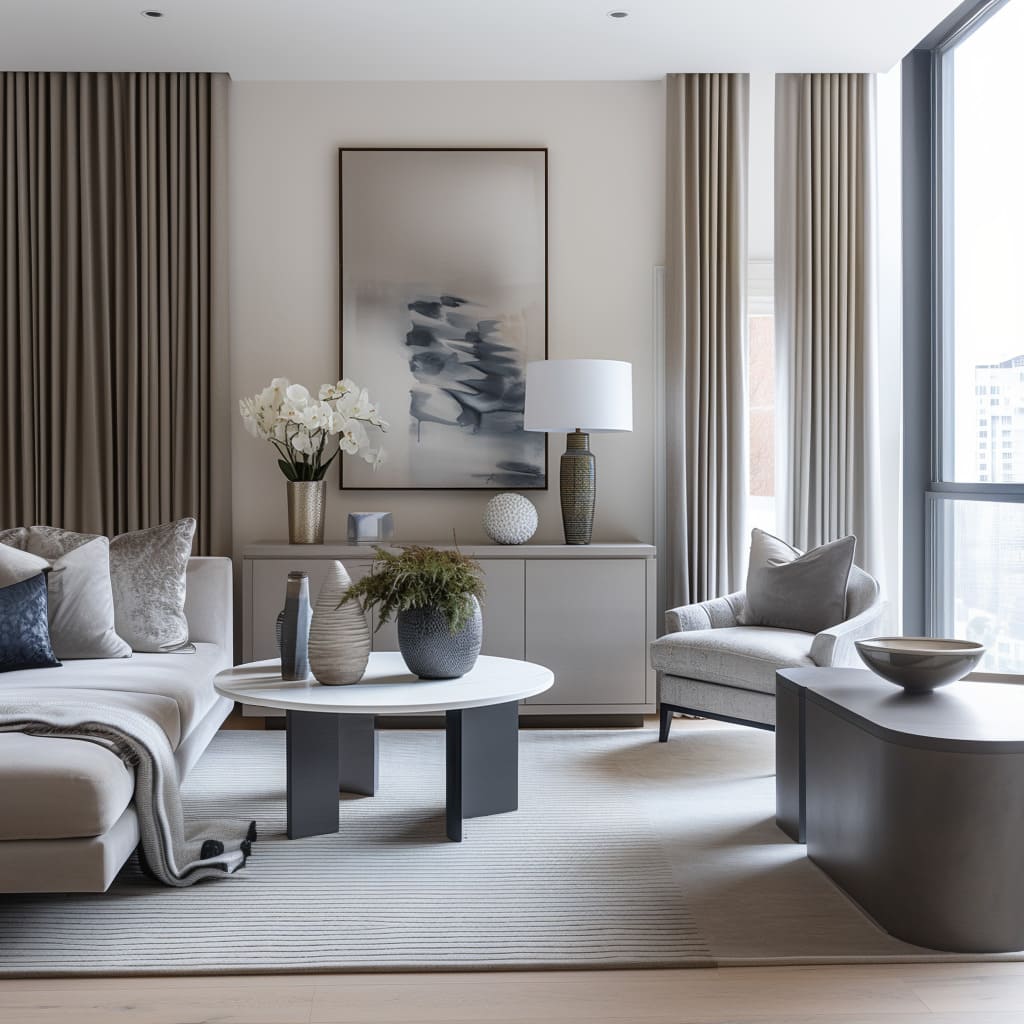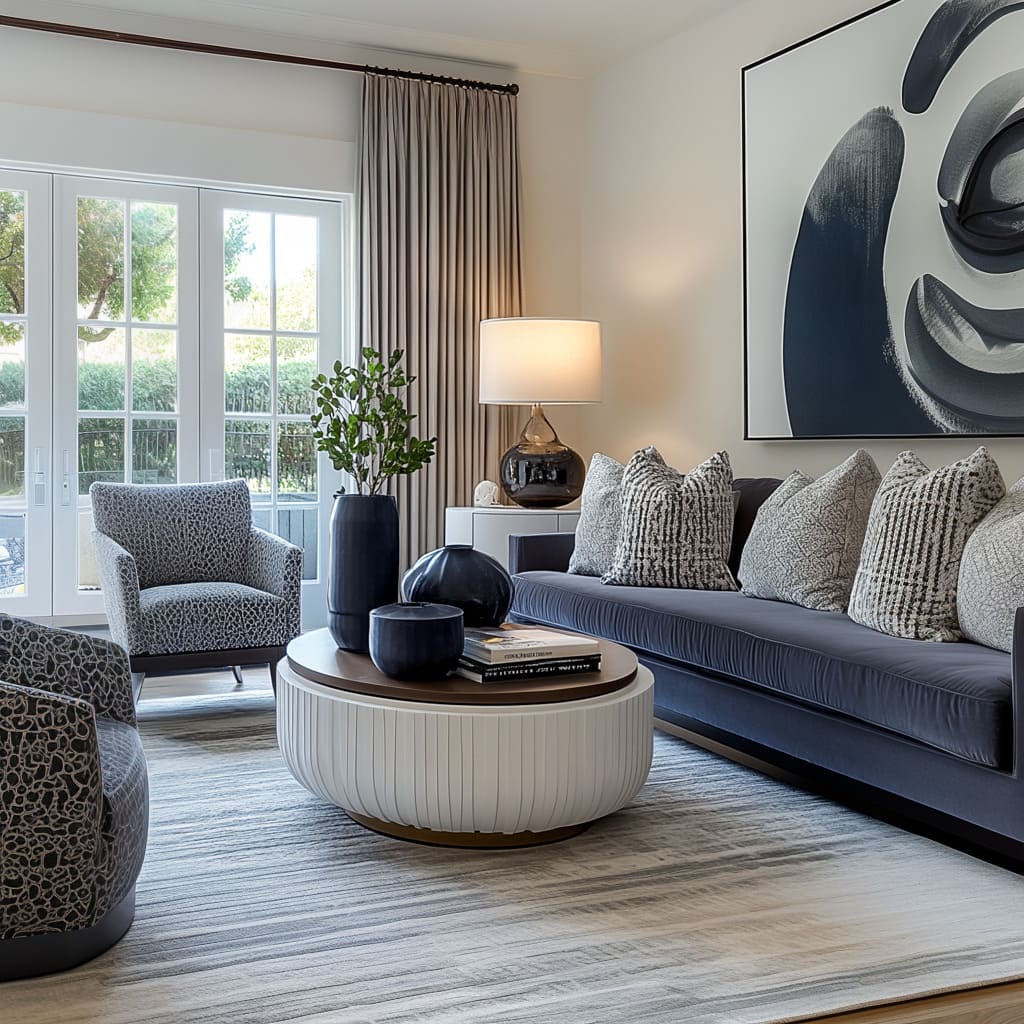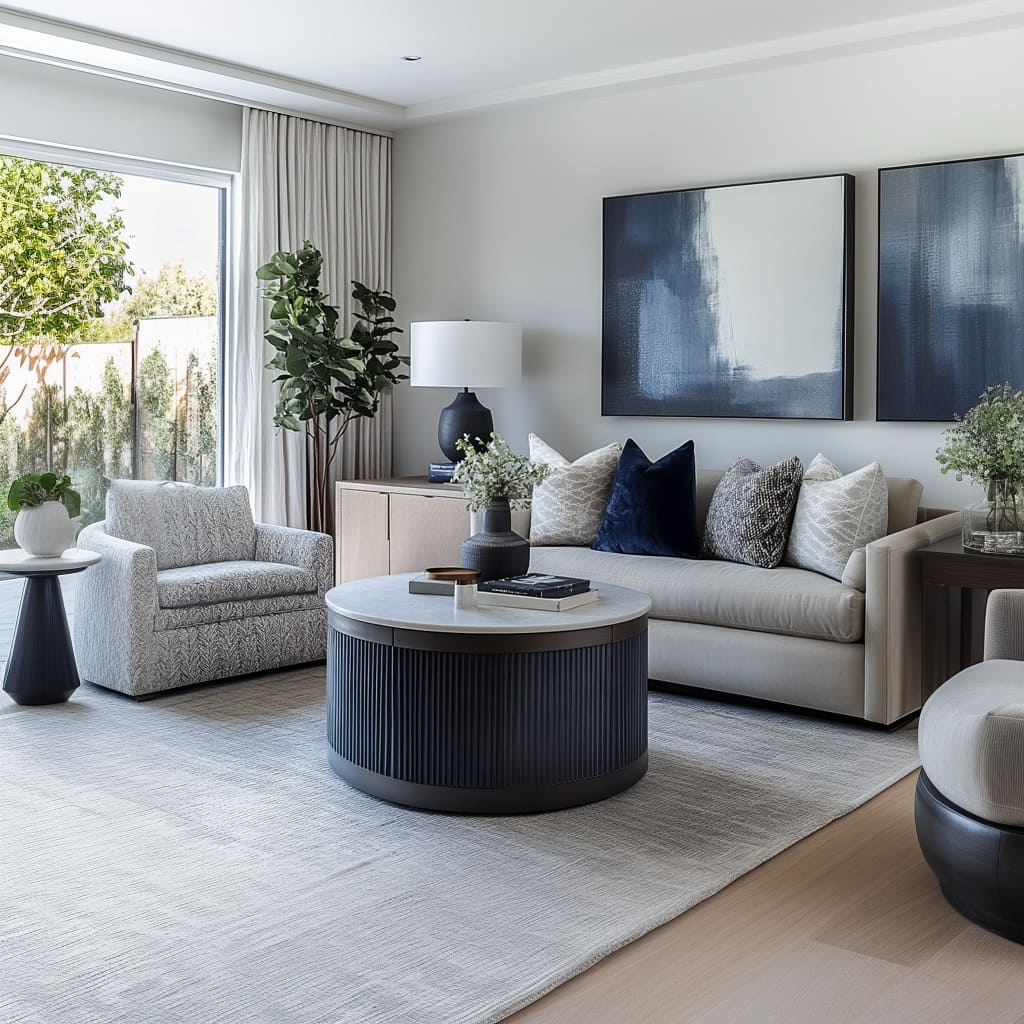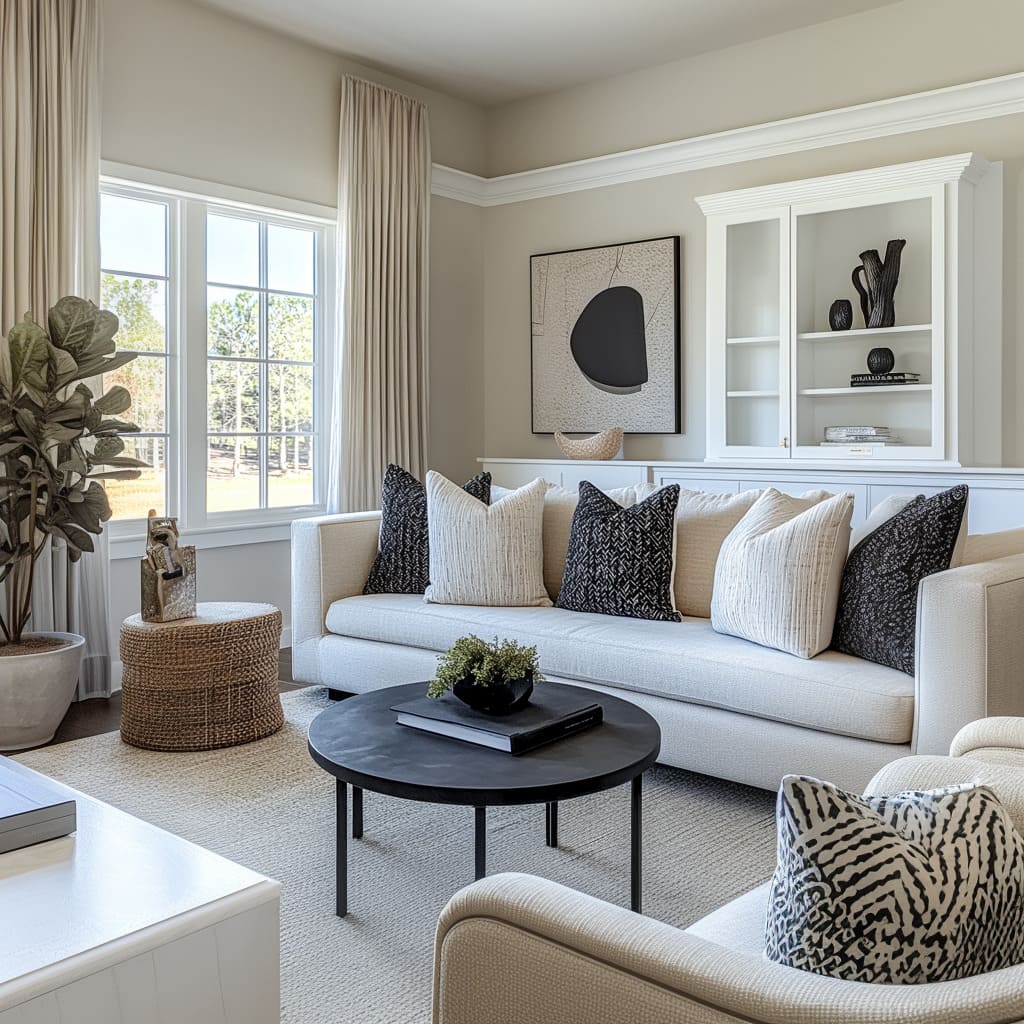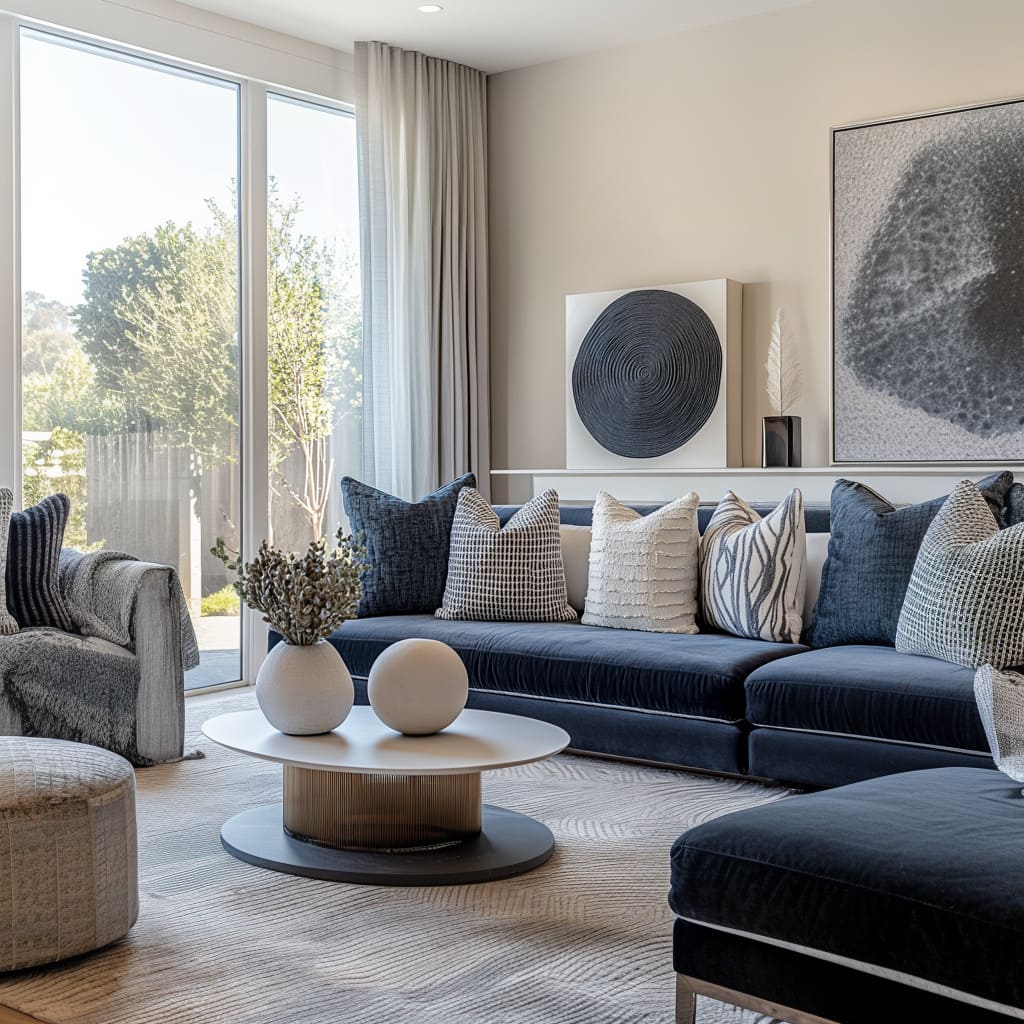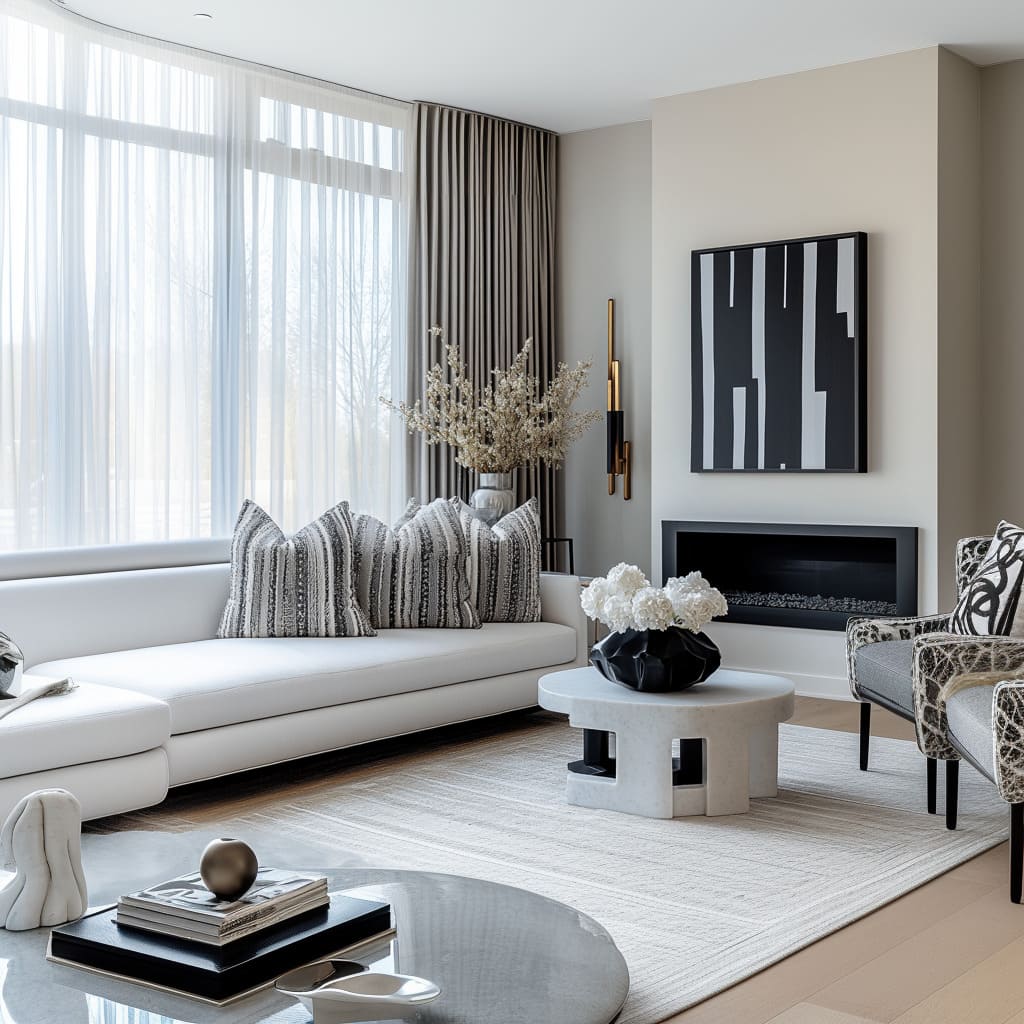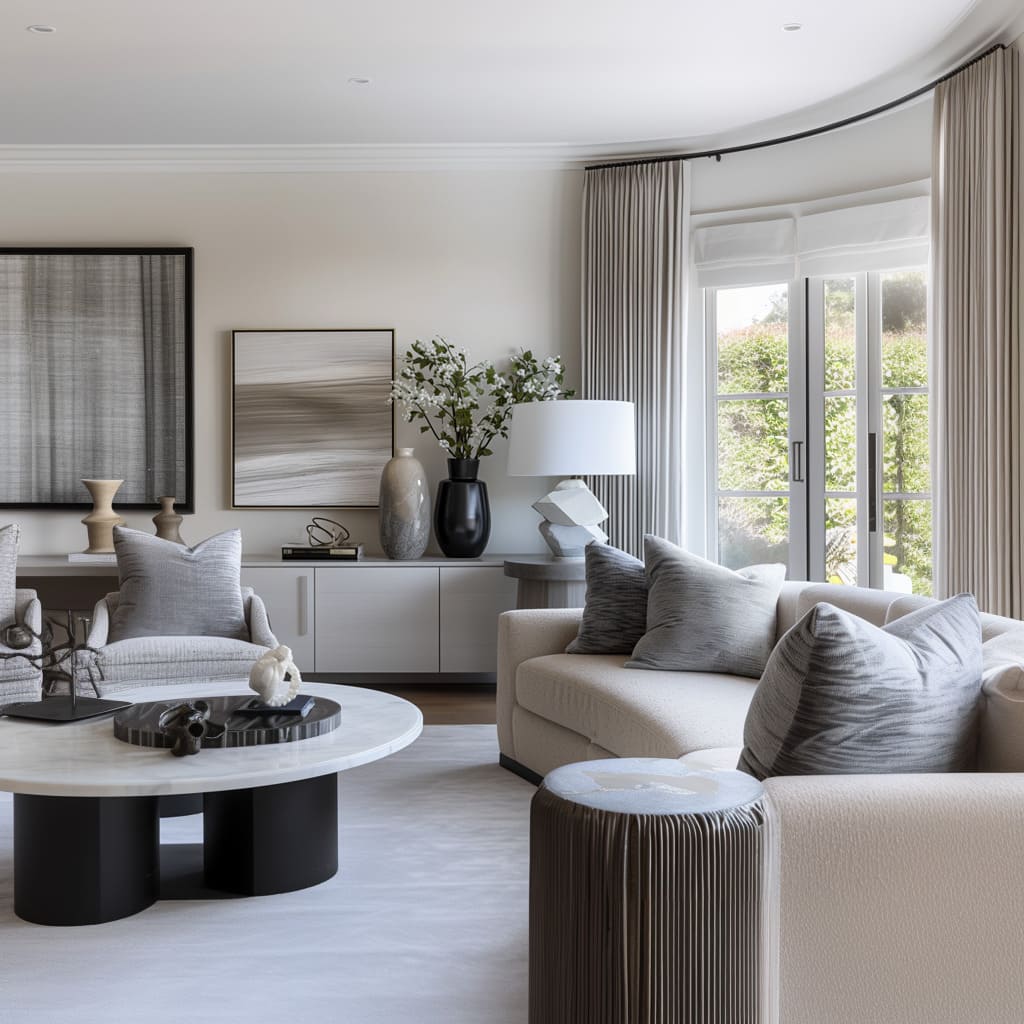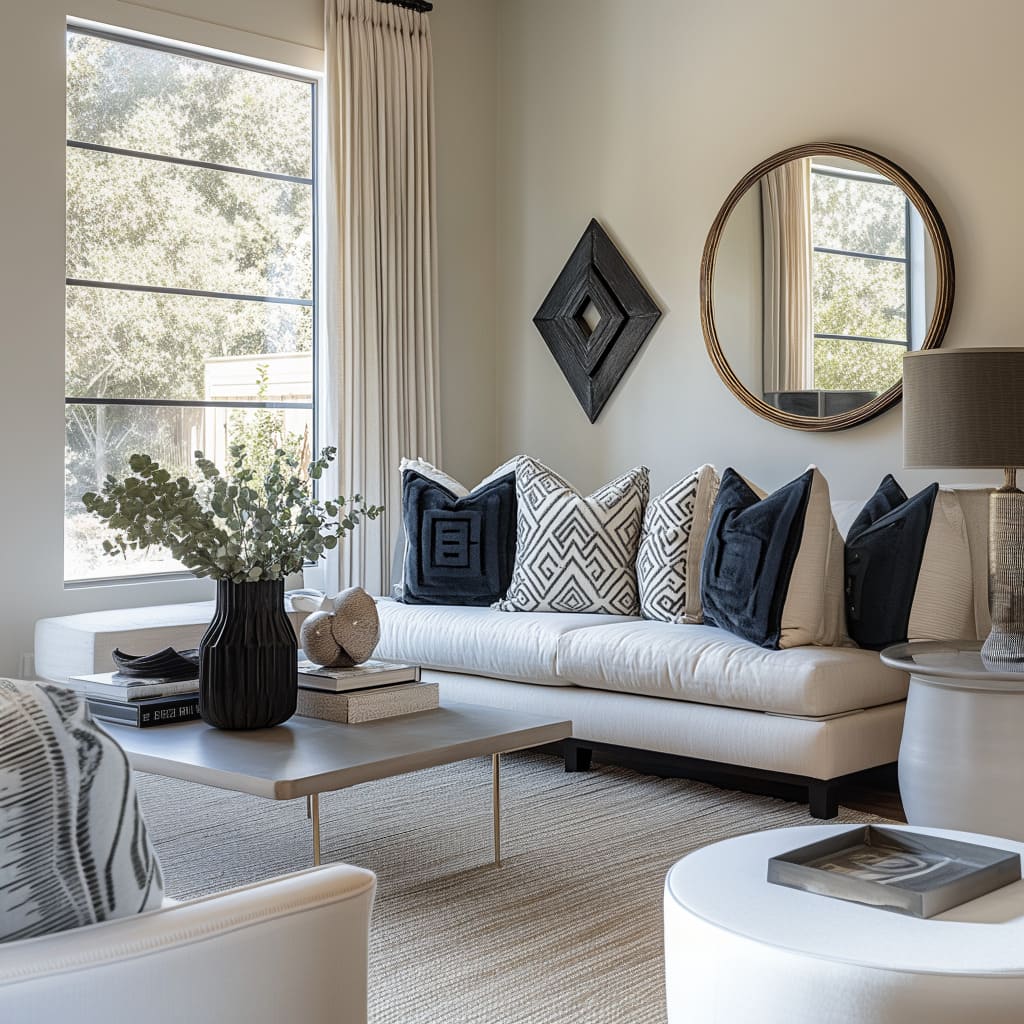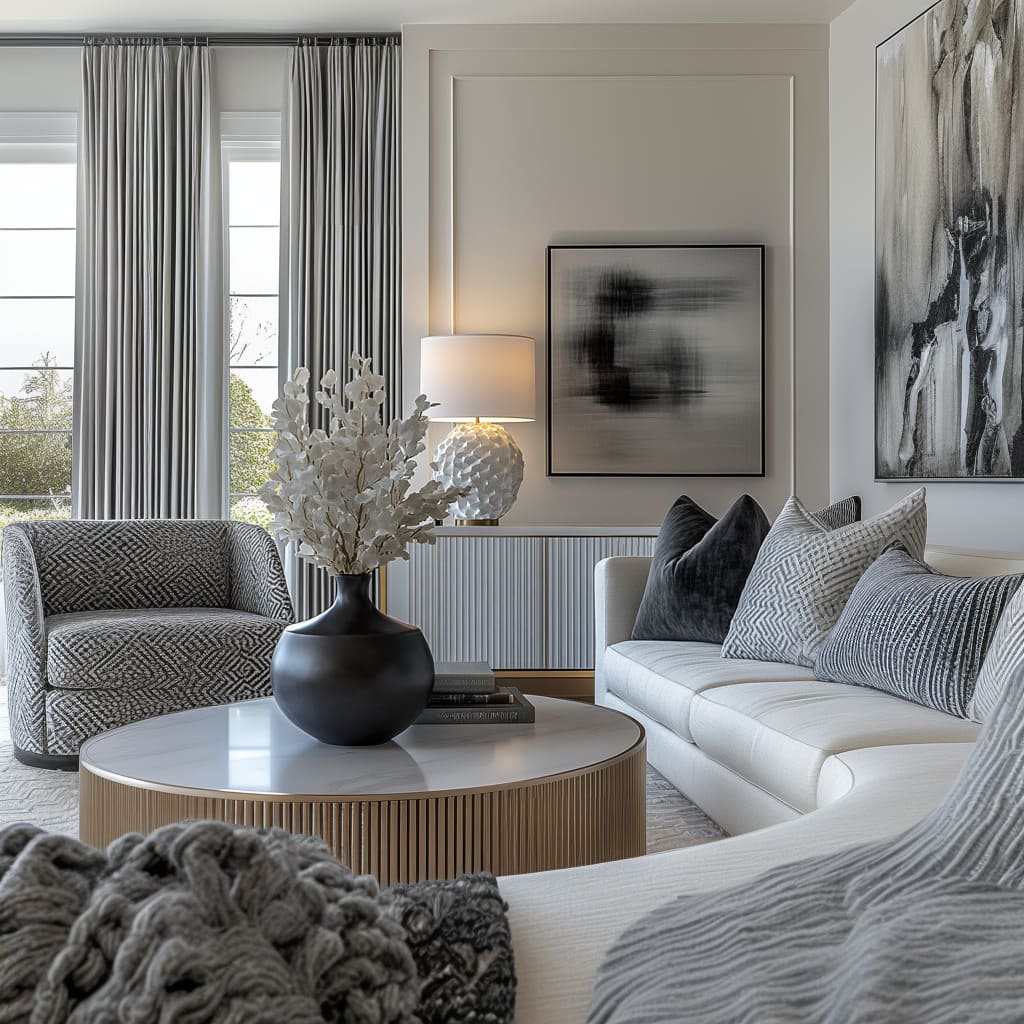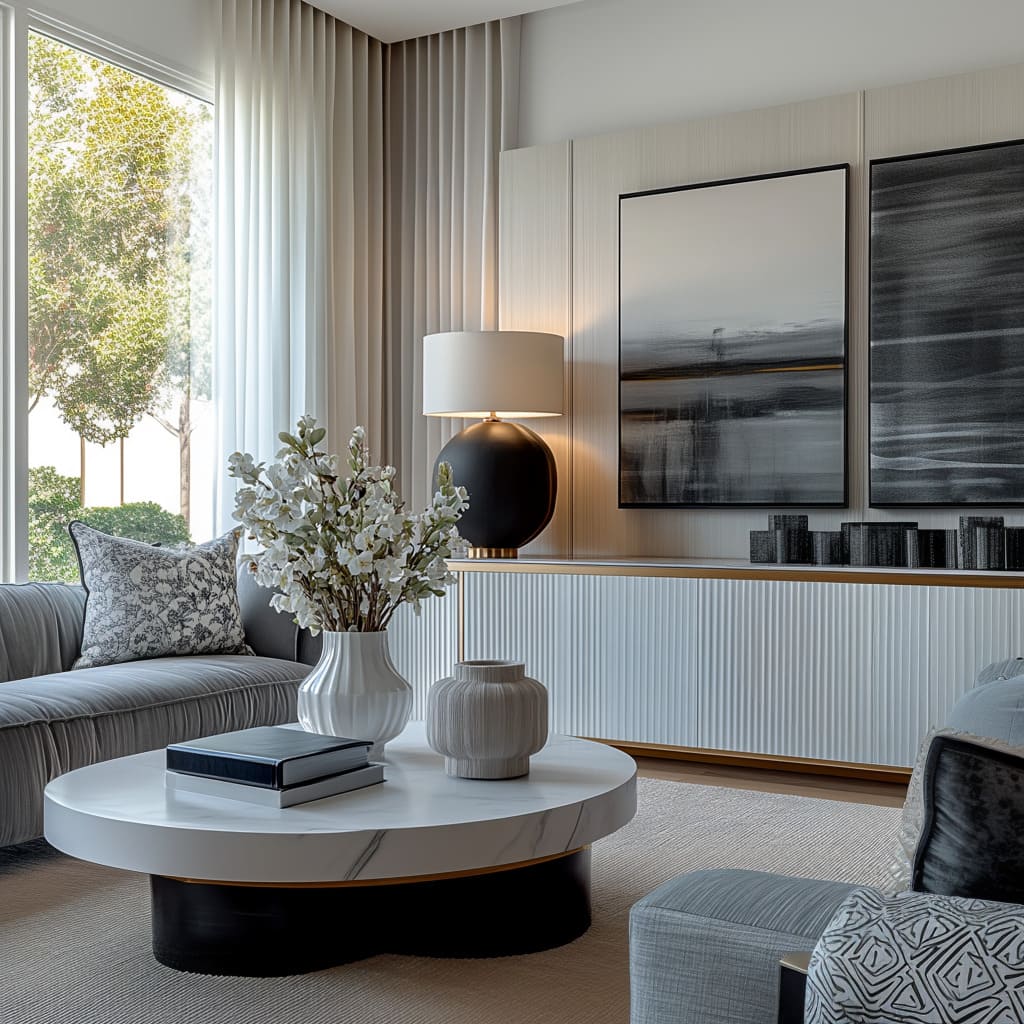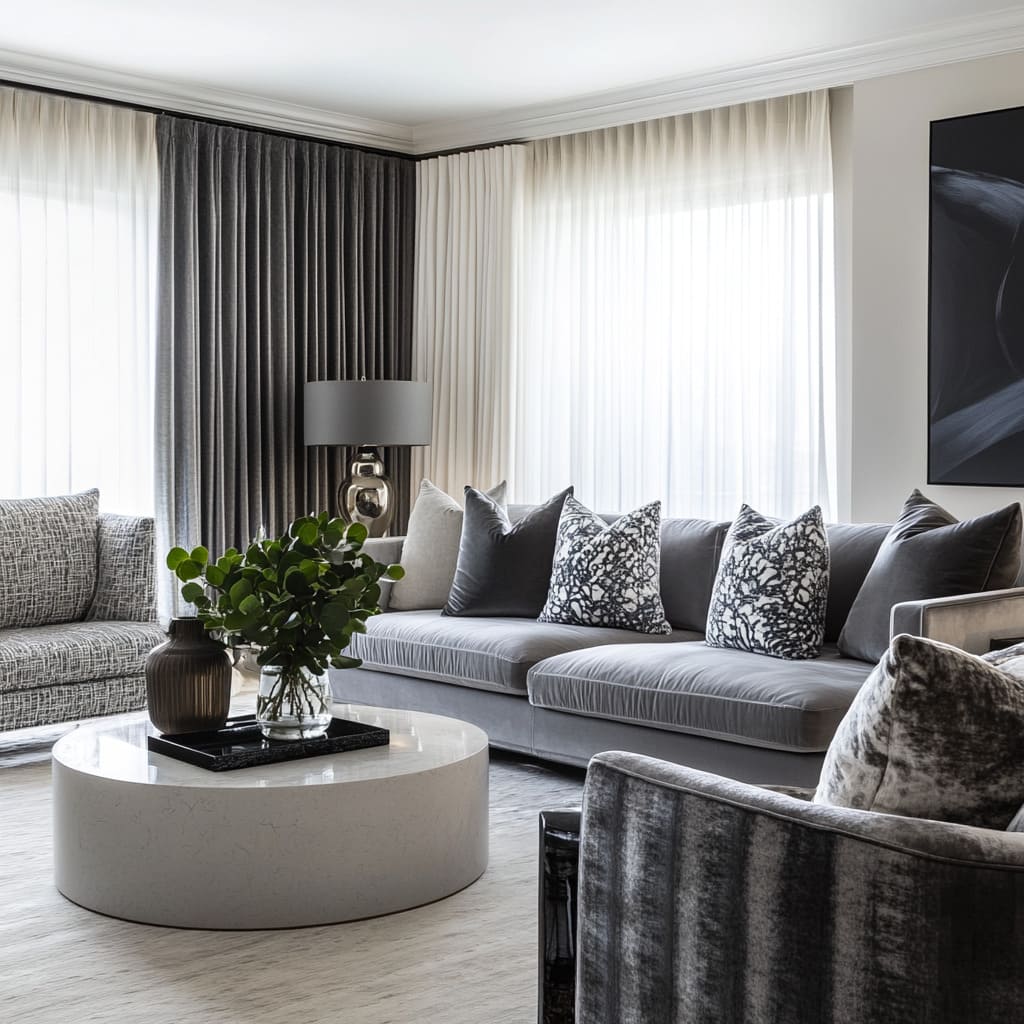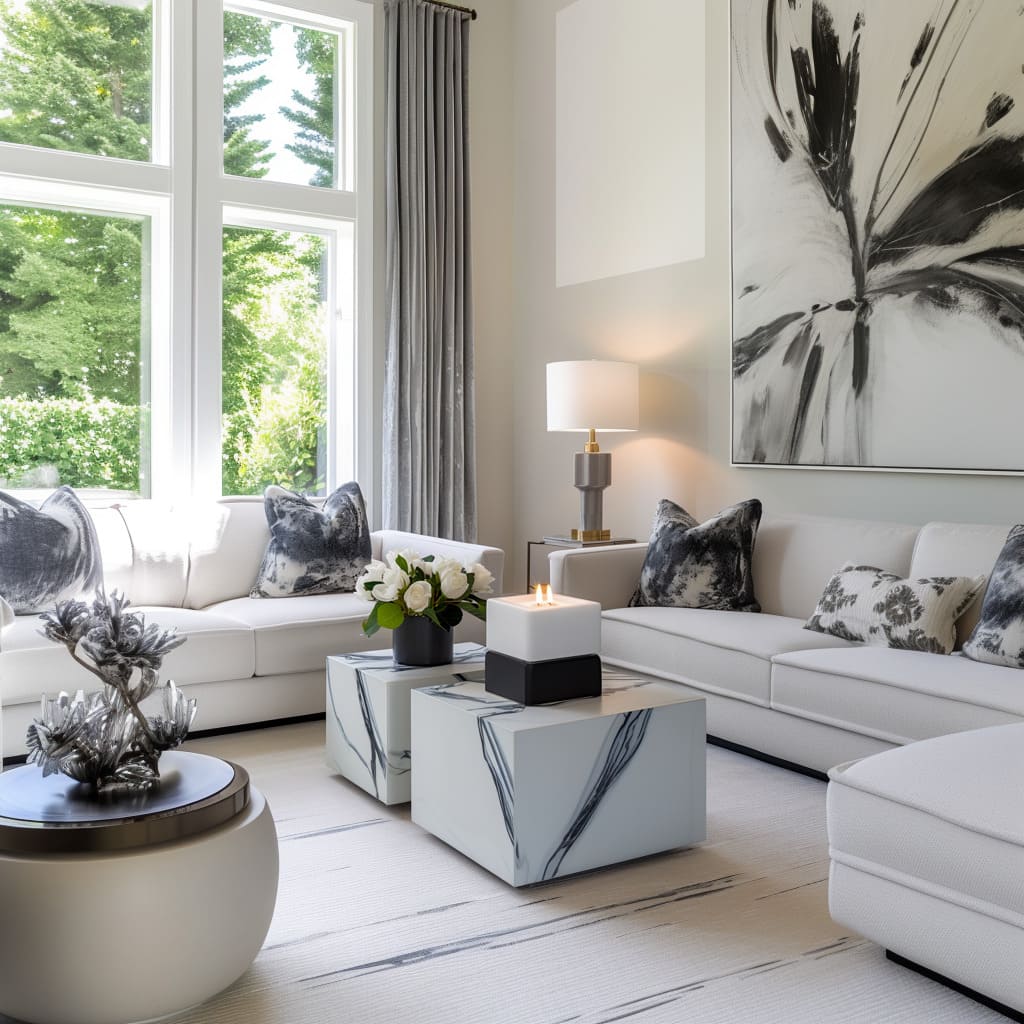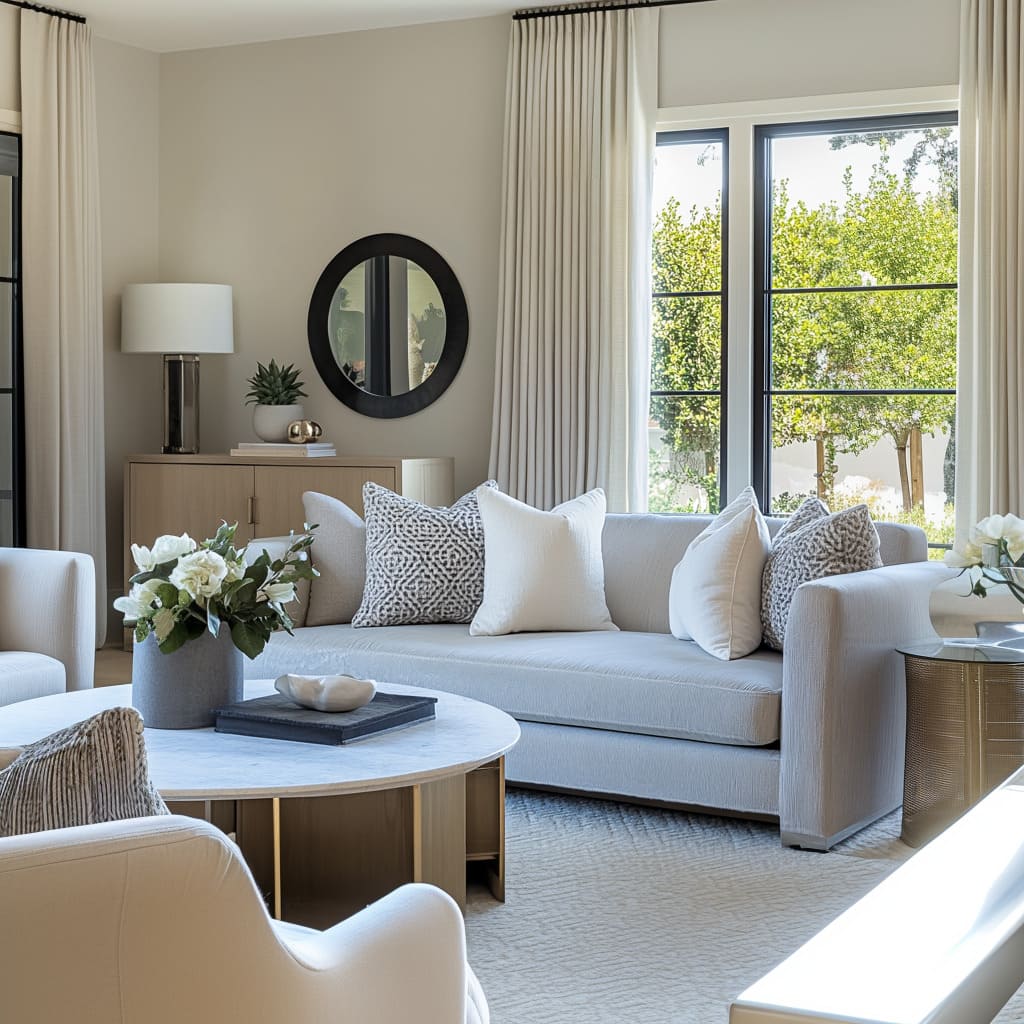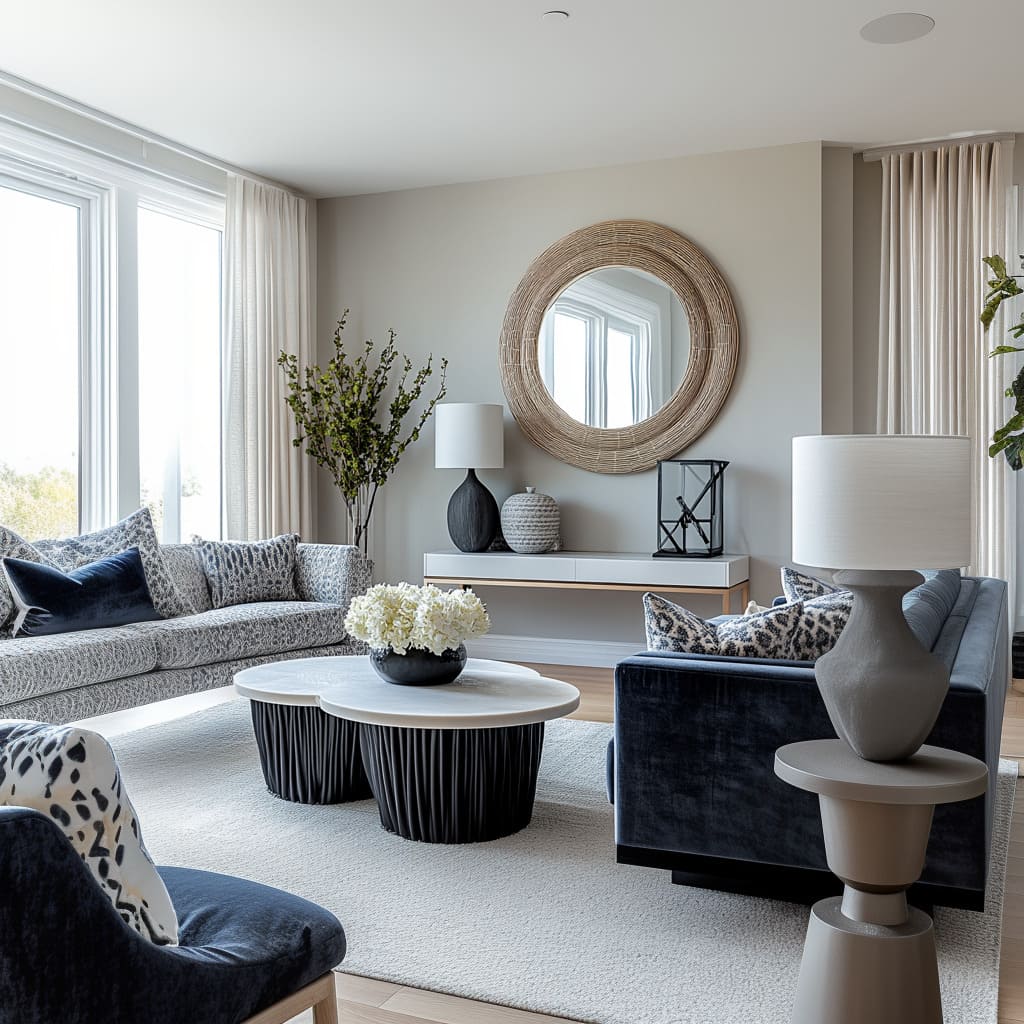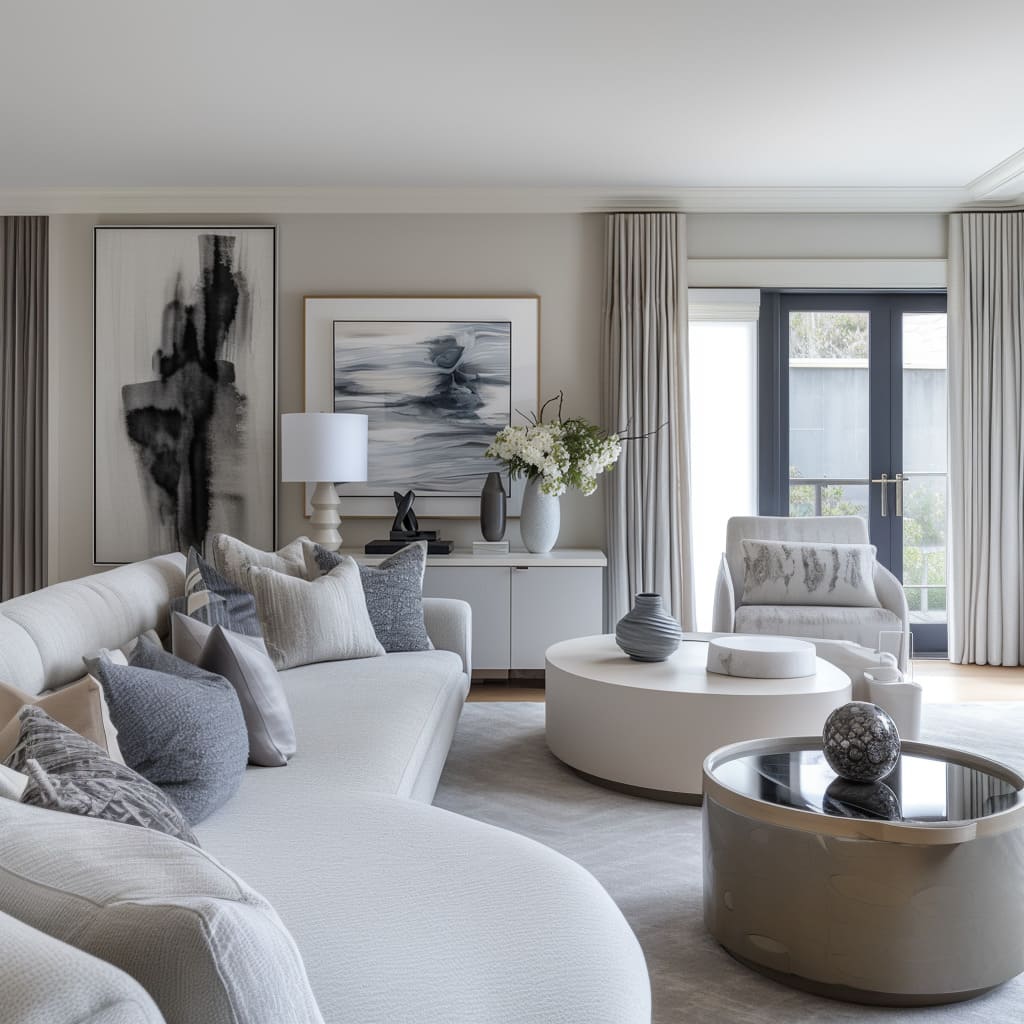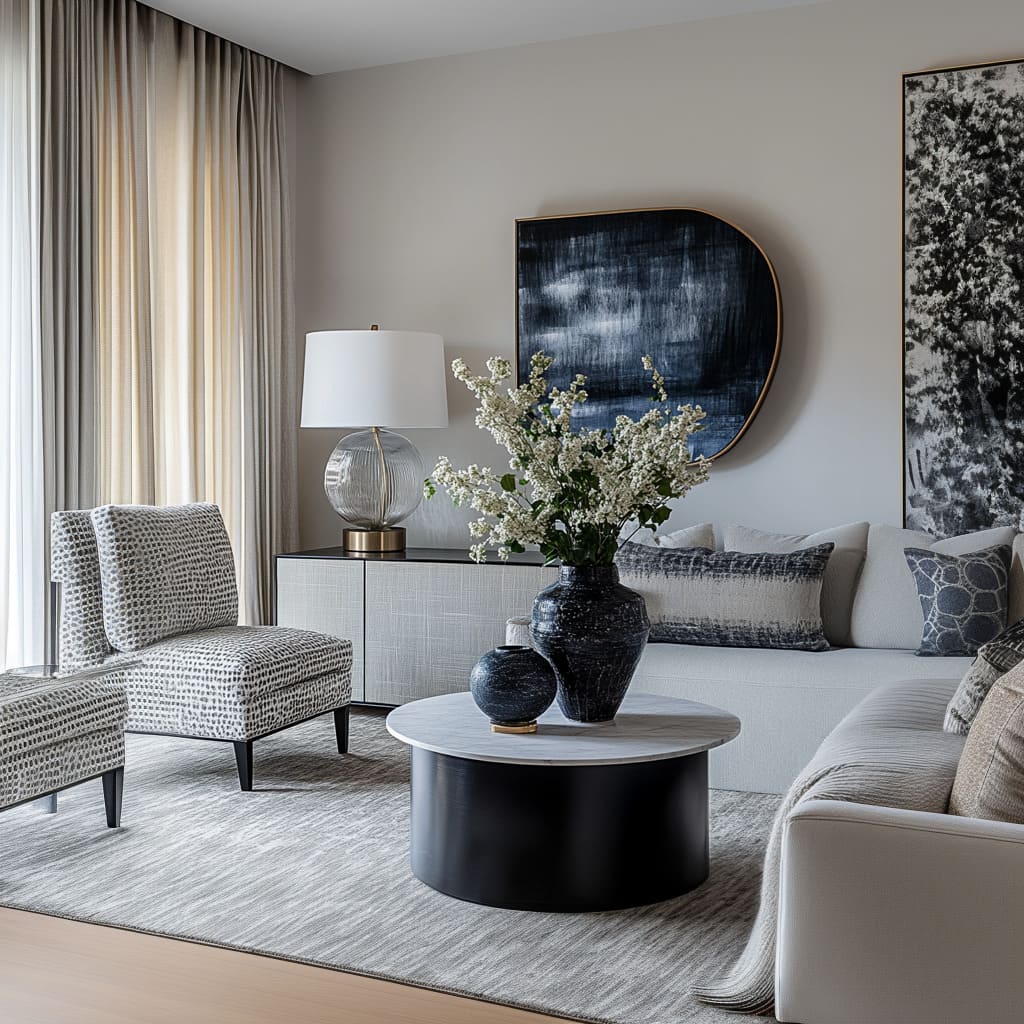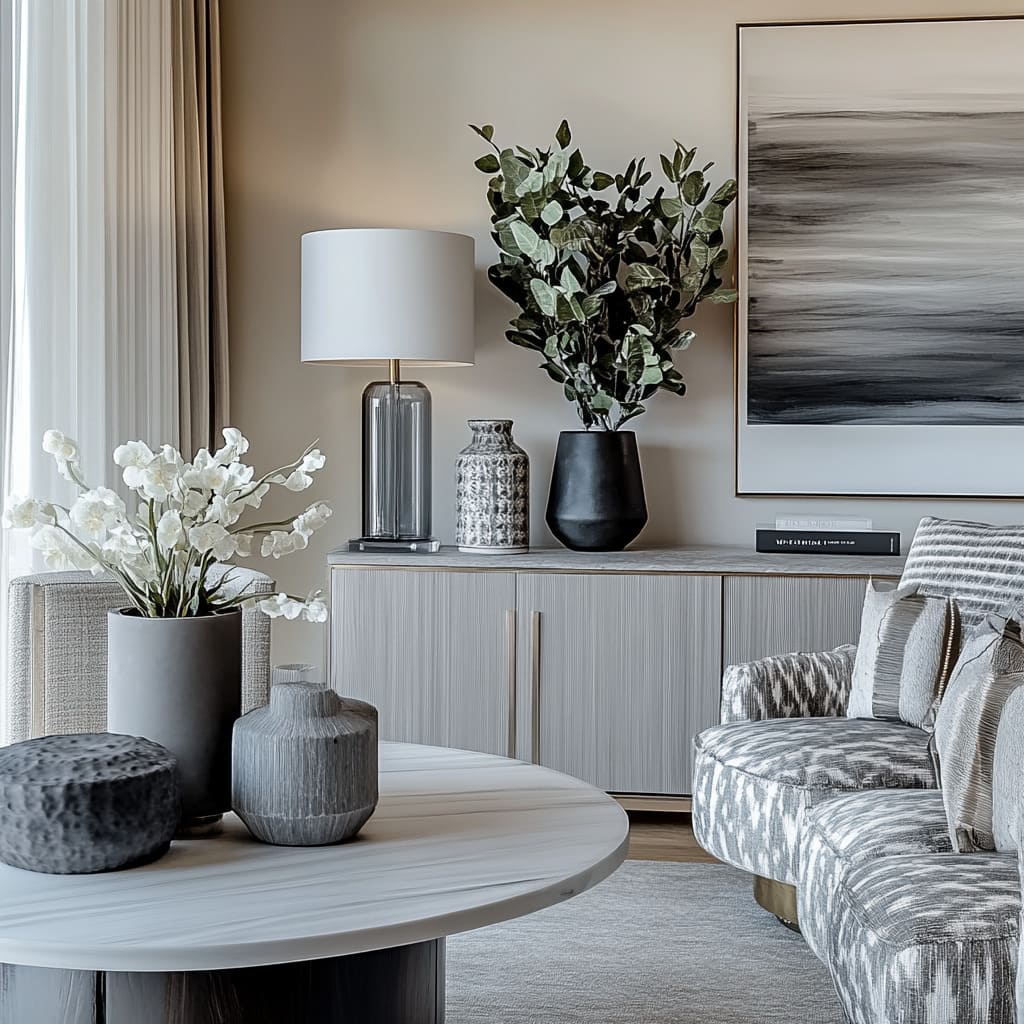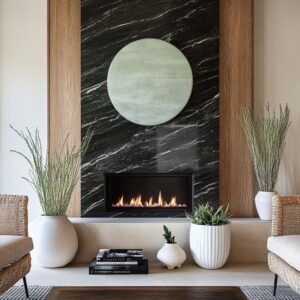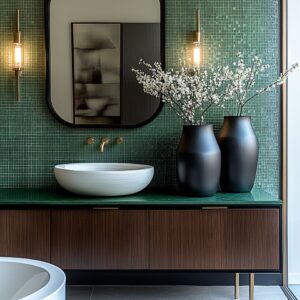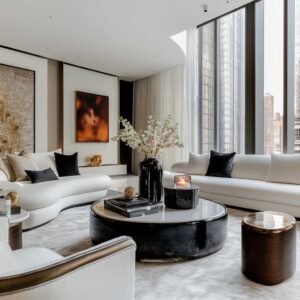Designing a grey living room offers an opportunity to create a space that feels both calming and contemporary. Grey tones can serve as a flexible foundation—ranging from warm and inviting to crisp and understated.
This color family pairs effortlessly with accents in black, white, and earthier hues, allowing for variations that suit many personal styles. At the same time, it provides an understated canvas where texture, furniture shapes, and decorative accents truly shine.
By mixing slightly different shades of grey on walls, sofas, and accessories, you can form a subtle layered look that keeps the room visually interesting. Textured materials—such as velvet cushions, woven rugs, and matte ceramic pieces—add depth, ensuring the design goes beyond a flat, monotone effect.
In addition, carefully chosen lighting and artwork can highlight standout pieces while creating an inviting glow. The following guide explores the best ways to bring together these elements to form a grey living room that combines comfort with a tastefully curated style.
Establish a Balanced Color Foundation
Every room begins with its palette, and selecting the right tones of grey can dramatically influence the overall feel. By layering different shades, you add richness and avoid a flat appearance.
Integrating subtle contrasts, like off-white or light beige, prevents the color scheme from looking too chilly. Gentle variations in hue will ensure your grey living room looks intentional and refined.
- Layered Greys: Use more than one shade of grey to bring dimension, rather than relying on a single uniform tone. Light grey walls can mix with a sofa in a deeper shade, accented by soft grey or charcoal pillows.
- Soft Neutrals for Contrast: Introduce neutrals such as off-whites or creams in curtains, rug, or cushions. These paler tones offset the cooler nature of grey, making the space feel more comfortable.
- Strategic Dark Notes: Intersperse black objects—for instance, lamps, frames, or small tables—to ground the look. These darker hints guide the eye and emphasize the lighter greys.
Design Spark
Consider the mood you want: if you prefer a calm vibe, select a grey with faint warm undertones. If a fresher atmosphere is desired, go for a grey that hints at blue.
Make sure the chosen shades complement each other so the contrast is gentle rather than harsh. A carefully curated palette will tie everything together in a harmonious manner.
Furniture Selection and Arrangement
Furniture sets both the tone and functionality of any living room. In a grey-themed space, choosing items that balance comfort with visual interest can define your entire design.
From plush sofas to handy side tables, each piece plays a role in shaping the area. Where you place them determines how people interact and move around.
- Seating Choices: A medium-grey sofa offers a solid base. Accent chairs in either a lighter grey or a subtle geometric print add variation.
- Tables for Visual Rhythm: A round coffee table can punctuate the room, bringing a gentle shape amid the linear backdrop. Consider a marble top or matte finish paired with a darker base for some contrast.
- Functional Layout: Keep chairs and sofa oriented toward each other for conversation. Ensure pathways remain clear while still creating a snug arrangement.
Creative Cue
Try mixing forms: if your sofa is boxy, add curved chairs. This interplay of shapes provides energy and balances out the design.
Additionally, placing a wooden console behind the sofa or along a wall brings warmth without clashing with a grey-dominant scheme. Even a single curved accent piece can soften an otherwise angular setup.
Texture and Material Exploration
A monochromatic color palette risks feeling monotonous if textures are neglected. When different surfaces meet—like smooth ceramic, plush fabric, and gleaming metal—they create layers of detail.
This tactile variety not only adds visual appeal but also invites a more engaging experience. Textures can elevate a simple design into something far more captivating.
- Contrast Through Touch: Pair matte ceramics with metallic decor or mirrored finishes. Plush velvets or thick weaves against sleek tables generate contrast.
- Layered Soft Furnishings: A neutral rug featuring subtle patterns or tufting can ground the seating area. Throws and cushions with small-scale motifs or embroidered details introduce complexity.
Clever Move
Pay attention to finishes. Slightly reflective surfaces—like a glossy tray on a matte coffee table—draw attention in a subtle way.
Think of these shifts in texture as punctuation marks in your design, keeping the eye moving. A mixture of natural fibers, polished metals, and velvety fabrics can provide a balanced tapestry of materials.
Lighting Approach
Light is a critical factor that shapes the atmosphere of any room. In spaces dominated by grey, proper lighting prevents a dreary or overly cool sensation.
Both natural sunlight and artificial fixtures work together to highlight decorative details and create a comfortable glow. Balancing these sources makes a grey living room feel bright yet cozy.
- Natural Light Management: Sheer curtains in tones like pale grey or cream softly filter daylight. If extra privacy is needed, layer with denser drapes that blend into the wall color.
- Layered Artificial Lighting: Position floor lamps and table lamps strategically for a pleasing interplay of light. Lamps with translucent glass bases or smoky tones bring a modern flair.
Sly Strategy
Consider lamp shades that gently diffuse light rather than directing it harshly. This soft illumination is especially flattering for a grey palette, as it prevents shadows from looking stark.
Positioning lamps near reflective decor—like mirrored trays or metallic accents—can amplify brightness. Utilizing varied lamp styles (floor, table, or pendant) ensures an even and inviting look.
Artwork and Wall Décor
Walls act as a canvas for highlighting the room’s personality. Selecting the right pieces—be it abstract art, mirrors, or sculptural elements—can energize a grey room.
With carefully chosen décor, you can create focus points that enliven neutral surroundings. The result is a dynamic setting that maintains a balanced backdrop.
- Abstract Focal Points: Large-scale monochromatic or nearly monochromatic artworks can be dramatic yet complementary. Alternatively, a deep accent color in the painting adds a slight pop.
- Mirrors and Sculptural Features: A round mirror with a thin black frame can reflect both light and color, visually expanding the room. Wall-mounted sculptures or 3D panels introduce texture and dimension.
Innovative Note
Position artwork or sculptural items to align with notable furniture silhouettes, like centering a painting above the sofa. For something more playful, try off-center placement for asymmetry.
Make sure the style of your artwork resonates with your room’s theme—modern abstract pieces amplify a contemporary look, while neutral-toned landscapes can complement a more relaxed layout. You want each item on the wall to feel intentionally placed, not just filling space.
Decorative Accents and Greenery
Small accents often carry big impact when it comes to styling. Vases, plants, and ornamental objects act as finishing touches that personalize a room.
The right selection can add a spark of nature, highlight certain features, or underscore the overarching color scheme. In a grey living room, these details help round out the design.
- Botanical Contrast: Potted plants or leafy branches break up grey elements. Large varieties can stand on the floor, while petite succulents or herbs occupy shelves or coffee tables.
- Metallic Notes: Light touches of brass, copper, or steel can bring a gentle glow. Think lamp bases, decorative bowls, or photo frames.
- Curated Vignettes: Group together items of varying heights or shapes on coffee tables or shelves. Keep them within the grey, black, or white family for harmony.
Adept Angle
When choosing greenery, consider the shape and texture of the leaves—broad leaves add bold presence, while wispy foliage suits a more delicate theme. If you favor metallics, aim for consistency in tone (all brass, all nickel, etc.
) for a polished effect. Spread out these accents so they don’t cluster in one corner.
A balanced distribution keeps the entire space feeling cohesive.
Subtle Artistic Twists
This section is about adding quiet surprises and layers of interest. Even in a minimal or neutral environment, a few well-chosen design details can stand out.
Subtle twists can come from patterns, shapes, or an unexpected piece of décor. The point is to personalize your grey living room in a way that feels distinctive yet not overwhelming.
- Patterns with Restraint: Look for designs in rugs, pillows, or curtains with geometric or abstract shapes in a gentle color scheme. This approach adds depth while preserving harmony.
- Mix Old and New: Pair a modern grey sofa with a vintage side table or a reclaimed wood console. These combinations enrich the setting and highlight each piece’s uniqueness.
Fresh Take
Repeat a certain shape—like circles—in different parts of the room: round mirrors, cylindrical vases, curved chairs. This visual echo shapes a pleasing sense of unity.
If an antique item feels out of place, tie it in with a small flourish that echoes its color or material, ensuring a seamless blend. Fusing different eras can create a layout that feels personal and storied, not like a showroom.
Ensuring Practical Comfort
A visually beautiful space should also function well. From selecting seats that are genuinely comfortable to allowing enough room to walk, practical considerations ensure daily ease.
Grey living rooms can sometimes look formal if they’re too sparsely furnished, so good choices in layout help strike the right balance. This section focuses on comfort, movement, and adaptability.
- Room Flow: Position your furniture so people can pass through without obstruction. Leave space around coffee tables and console areas.
- Versatile Pieces: An ottoman that doubles as a storage box can hide blankets or magazines. Side tables you can tuck away or move around add convenience.
Savvy Tip
Think about how you’ll use the space day to day. Do you need a spot for remote controls, a reading nook, or an area for entertaining guests?
Arrange furniture with those real-life scenarios in mind. Multi-purpose seating and moveable tables keep things flexible, ensuring the room remains both stylish and functional.
Final Thoughts on Creating a Stylish Grey Living Room
Bringing all these ideas together gives you a grey living room that looks cohesive and feels relaxing. By interweaving texture, strategic color contrasts, and carefully chosen décor, you create an inviting retreat for both everyday living and social gatherings.
Grey, though often seen as neutral, can actually be a wonderful canvas for creativity. The essence lies in refining each layer so every piece feels purposeful.
- Texture Variety: Use plush cushions, sleek ceramics, and woven rugs for gentle diversity. Contrast is the key to preventing boredom in a toned-down scheme.
- Smart Furniture Groupings: Cluster seating around key focal points—like a coffee table, TV, or fireplace—to encourage conversation. A balanced arrangement enhances sociability.
- Layered Lighting: Embrace sunlight, then add lamps and overhead fixtures for evening. Well-placed lighting can shift the mood from bright to calm.
Final Touch
Keep reevaluating as you add or remove items. If the room feels too cold, introduce additional neutrals or subtle wooden elements.
If it looks busy, simplify by removing excess patterns and focusing on a few statement pieces.
